Document 1
Exhibit No. 99.1
News Release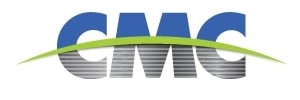

CMC REPORTS SECOND QUARTER FISCAL 2025 RESULTS
•Second quarter net earnings of $25.5 million, or $0.22 per diluted share; adjusted earnings of $29.3 million, or $0.26 per diluted share
•Consolidated core EBITDA of $131.0 million in the second quarter; core EBITDA margin of 7.5%
•Solid North American construction demand drove a 3.3% increase in finished steel shipments compared to the prior year second quarter
•New project awards reached the second highest level since late fiscal 2022, leading to a healthy North America backlog volume that grew sequentially and was stable on a year-over-year basis
•Europe Steel Group achieved adjusted EBITDA breakeven during the quarter, driven by effective cost management and modest margin relief
•Profitability in the Emerging Businesses Group increased both sequentially and on a year-over-year basis, despite seasonal headwinds
•Execution of long-term strategic plan, including organic growth investments and the operational and commercial excellence program (“TAG”), is contributing positively to fiscal 2025 performance
Irving, TX - March 20, 2025 - Commercial Metals Company (NYSE: CMC) today announced financial results for its fiscal second quarter ended February 28, 2025. Second quarter net earnings was $25.5 million, or $0.22 per diluted share, on net sales of $1.8 billion, compared to prior year period net earnings of $85.8 million, or $0.73 per diluted share, on net sales of $1.8 billion.
During the second quarter of fiscal 2025, the Company recorded estimated net after-tax charges of $3.9 million primarily to reflect interest expense on the judgment amount associated with the previously disclosed Pacific Steel Group litigation. Excluding these charges, second quarter adjusted earnings were $29.3 million, or $0.26 per diluted share, compared to adjusted earnings of $85.9 million, or $0.73 per diluted share, in the prior year period. "Adjusted EBITDA," "core EBITDA," "core EBITDA margin," "adjusted earnings" and "adjusted earnings per diluted share" are non-GAAP financial measures. Details, including a reconciliation of each such non-GAAP financial measure to the most directly comparable measure prepared and presented in accordance with GAAP, can be found in the financial tables that follow.
Peter Matt, President and Chief Executive Officer, said, “In our seasonally weaker second quarter, during a period of continued economic uncertainty, the CMC team bolstered profitability across each segment by targeted actions to increase commercial discipline and optimize costs, in order to support higher margins. These efforts drove improved sequential profitability within our Europe Steel Group (excluding energy credits and rebates) and our Emerging Businesses Group, and ran counter to normal seasonal trends. Our initiatives are also contributing to financial results in our North America Steel Group, where the business remained under pressure from margin
(CMC Second Quarter Fiscal 2025 - 2)
compression in most lines of business. Encouragingly, several bright spots emerged in our North American steel business during the second half of the quarter, including improved scrap market conditions, rising long steel prices, a rebound in downstream project awards, and better price levels for new downstream work. Taken together, we believe these developments signal a near-term inflection in profitability levels heading into the spring and summer construction season."
Mr. Matt added, "Infrastructure spending remains robust and conversations with customers across other sectors and geographies continue to point toward optimism for construction activity in the quarters ahead. This sentiment is consistent with our downstream bid levels and key external indicators that suggest a strong and growing pipeline of potential future projects. We remain confident in the long-term fundamentals of the U.S. construction market, driven by structural trends including infrastructure investment, reshoring of critical manufacturing, energy transition and generation growth, and the need to address our nation's housing shortage."
Mr. Matt added, "Execution of our operational and commercial excellence program, Transform, Advance, and Grow (TAG), continued to gain momentum during the quarter and is on pace to provide the financial benefits we anticipated in fiscal 2025, with more expected to be delivered in the years beyond. This effort is a key component of our long-term strategic plan and is expected to propel value by helping CMC to drive commercial and operational excellence and other efficiencies across the organization and to achieve higher through-the-cycle margins."
The Company's balance sheet and liquidity position remained strong. As of February 28, 2025, cash and cash equivalents totaled $758.4 million, with available liquidity of nearly $1.6 billion. During the quarter, CMC repurchased 906,603 shares of common stock valued at $48.0 million in the aggregate. As of February 28, 2025, $305.3 million remained available under the current share repurchase authorization.
On March 19, 2025, the board of directors declared a quarterly dividend of $0.18 per share of CMC common stock payable to stockholders of record on March 31, 2025. The dividend to be paid on April 9, 2025, marks the 242nd consecutive quarterly payment by the Company.
(CMC Second Quarter Fiscal 2025 - 3)
Business Segments - Fiscal Second Quarter 2025 Review
Demand for CMC’s products in North America was resilient during the quarter. Shipments of finished steel products increased by 3.3% relative to the prior year period. The pipeline of potential future construction projects remained healthy as indicated by CMC’s downstream bidding activity and the Dodge Momentum Index, which measures the value of projects entering the planning phase. Downstream backlog volumes increased by nearly 10% relative to the end of the first fiscal quarter and were stable on a year-over-year basis. New contract awards improved during the second quarter and ended the period at the second highest volume since late fiscal 2022. Shipments of merchant products (MBQ) grew compared to the second quarter of fiscal 2024 as CMC has increased its ability to serve West Coast customers from the Arizona 2 micro mill.
Long steel market conditions improved throughout the quarter from a low point reached in December 2024. Domestic scrap pricing rose in both January and February prompting price increases for each of CMC’s primary steel products. The supply of imported rebar remained modest relative to the longer-term average, despite a temporary jump in arrivals during January ahead of potential tariff implementations.
Adjusted EBITDA for the North America Steel Group decreased to $128.8 million in the second quarter of fiscal 2025 from $222.3 million in the prior year period. The earnings reduction was driven by lower margins over scrap costs on steel products and downstream products. Results for the second quarter also included unrealized losses of approximately $8 million related to financial positions used to hedge CMC's physical copper exposure. The adjusted EBITDA margin for the North America Steel Group of 9.3% declined from 15.0% in the second quarter of fiscal 2024.
European market conditions in the second quarter improved modestly relative to recent periods, largely due to reduced import flows that helped establish a better balance of supply and demand. Lower import entries into the Polish market provided domestic suppliers with the ability to increase market penetration and maintain good shipment volumes despite seasonal headwinds. A sequential reduction in scrap costs led to a slight improvement in metal margins. Pricing trends within the quarter were positive, with monthly average selling prices ending the period $25 per ton above the low reached in December 2024. Financial results continued to benefit from an extensive cost management program that has meaningfully reduced controllable costs.
Adjusted EBITDA for the Europe Steel Group increased to $0.8 million in the second quarter of fiscal 2025 from a loss of $8.6 million in the prior year period. The second quarter results include a government rebate related to natural gas costs of $4.0 million. The adjusted EBITDA margin for the Europe Steel Group of 0.4% increased from (4.5%) in the second quarter of fiscal 2024.
Emerging Businesses Group (EBG) second quarter net sales of $158.9 million increased by 1.8% compared to the prior year period, while adjusted EBITDA for the segment of $23.5 million was up 31.2% on a year-over-year
(CMC Second Quarter Fiscal 2025 - 4)
basis. Improved segment profitability was driven by strong project related shipments of Performance Reinforcing Steel, as CMC continues to experience growing demand for its proprietary corrosion resistant solutions. Financial results within other EBG divisions were largely unchanged from the prior year period. Indications of future market conditions remained encouraging with pipeline measures such as project quotes and new planning activity at healthy levels. Adjusted EBITDA margin of 14.8% improved by 330 basis points compared to the prior year period.
Outlook
Mr. Matt said, “We expect consolidated financial results in our third quarter of fiscal 2025 to rebound from the second quarter level. Finished steel shipments within the North America Steel Group are anticipated to follow normal seasonal trends as we enter the spring and summer construction seasons, while our adjusted EBITDA margin is expected to increase sequentially on higher margins over scrap on steel products. Adjusted EBITDA for our Europe Steel Group should remain near breakeven, as we enter the seasonally strong period of the year and continue to benefit from extensive cost management efforts. Financial results for the Emerging Businesses Group are anticipated to improve to levels modestly above the prior year period.”
Mr. Matt concluded, “We are encouraged by recent developments across the various markets in which we participate. Margin and demand trends appear to be improving, which should position us well for the upcoming spring and summer construction season. Additionally, conversations with customers continue to indicate optimism about the coming quarters.”
Conference Call
CMC invites you to listen to a live broadcast of its second quarter fiscal 2025 conference call today, Thursday, March 20, 2025, at 11:00 a.m. ET. Peter Matt, President and Chief Executive Officer, and Paul Lawrence, Senior Vice President and Chief Financial Officer, will host the call. The call is accessible via our website at www.cmc.com. In the event you are unable to listen to the live broadcast, the call will be archived and available for replay on our website on the next business day. Financial and statistical information presented in the broadcast are located on CMC's website under "Investors."
About CMC
CMC is an innovative solutions provider helping build a stronger, safer, and more sustainable world. Through an extensive manufacturing network principally located in the United States and Central Europe, we offer products and technologies to meet the critical reinforcement needs of the global construction sector. CMC’s solutions support early-stage construction across a wide variety of applications, including infrastructure, non-residential, residential, industrial, and energy generation and transmission.
(CMC Second Quarter Fiscal 2025 - 5)
Forward-Looking Statements
This news release contains forward-looking statements within the meaning of the federal securities laws with respect to general economic conditions, key macro-economic drivers that impact our business, the effects of ongoing trade actions, the effects of continued pressure on the liquidity of our customers, potential synergies and growth provided by acquisitions and strategic investments, demand for our products, shipment volumes, metal margins, the ability to operate our steel mills at full capacity, future availability and cost of supplies of raw materials and energy for our operations, growth rates in certain reportable segments, product margins within our Emerging Businesses Group segment, share repurchases, legal proceedings, construction activity, international trade, the impact of geopolitical conditions, capital expenditures, tax credits, our liquidity and our ability to satisfy future liquidity requirements, estimated contractual obligations, the expected capabilities and benefits of new facilities, the anticipated benefits and timeline for execution of our growth plan and initiatives and our expectations or beliefs concerning future events. The statements in this release that are not historical statements, are forward-looking statements. These forward-looking statements can generally be identified by phrases such as we or our management "expects," "anticipates," "believes," "estimates," "future," "intends," "may," "plans to," "ought," "could," "will," "should," "likely," "appears," "projects," "forecasts," "outlook" or other similar words or phrases, as well as by discussions of strategy, plans or intentions.
The Company's forward-looking statements are based on management’s expectations and beliefs as of the time this news release was prepared. Although we believe that our expectations are reasonable, we can give no assurance that these expectations will prove to have been correct, and actual results may vary materially. Except as required by law, we undertake no obligation to update, amend or clarify any forward-looking statements to reflect changed assumptions, the occurrence of anticipated or unanticipated events, new information or circumstances or any other changes. Important factors that could cause actual results to differ materially from our expectations include those described in our filings with the Securities and Exchange Commission, including, but not limited to, in Part I, Item 1A, "Risk Factors" of our annual report on Form 10-K for the fiscal year ended August 31, 2024, as well as the following: changes in economic conditions which affect demand for our products or construction activity generally, and the impact of such changes on the highly cyclical steel industry; rapid and significant changes in the price of metals, potentially impairing our inventory values due to declines in commodity prices or reducing the profitability of downstream contracts within our vertically integrated steel operations due to rising commodity pricing; excess capacity in our industry, particularly in China, and product availability from competing steel mills and other steel suppliers including import quantities and pricing; the impact of geopolitical conditions, including political turmoil and volatility, regional conflicts, terrorism and war on the global economy, inflation, energy supplies and raw materials; increased attention to environmental, social and governance ("ESG") matters, including any targets or other ESG, environmental justice or regulatory initiatives; operating and startup risks, as well as market risks associated with the commissioning of new projects could prevent us from realizing anticipated benefits and could result in a loss of all or a substantial part of our investments; impacts from global public health crises on the economy, demand for our products, global supply chain and on our operations; compliance with and changes in
(CMC Second Quarter Fiscal 2025 - 6)
existing and future laws, regulations and other legal requirements and judicial decisions that govern our business, including increased environmental regulations associated with climate change and greenhouse gas emissions; involvement in various environmental matters that may result in fines, penalties or judgments; evolving remediation technology, changing regulations, possible third-party contributions, the inherent uncertainties of the estimation process and other factors that may impact amounts accrued for environmental liabilities; potential limitations in our or our customers' abilities to access credit and non-compliance with their contractual obligations, including payment obligations; activity in repurchasing shares of our common stock under our share repurchase program; financial and non-financial covenants and restrictions on the operation of our business contained in agreements governing our debt; our ability to successfully identify, consummate and integrate acquisitions and realize any or all of the anticipated synergies or other benefits of acquisitions; the effects that acquisitions may have on our financial leverage; risks associated with acquisitions generally, such as the inability to obtain, or delays in obtaining, required approvals under applicable antitrust legislation and other regulatory and third-party consents and approvals; lower than expected future levels of revenues and higher than expected future costs; failure or inability to implement growth strategies in a timely manner; the impact of goodwill or other indefinite-lived intangible asset impairment charges; the impact of long-lived asset impairment charges; currency fluctuations; global factors, such as trade measures, military conflicts and political uncertainties, including changes to current trade regulations, such as Section 232 trade tariffs and quotas, tax legislation and other regulations which might adversely impact our business; availability and pricing of electricity, electrodes and natural gas for mill operations; our ability to hire and retain key executives and other employees; competition from other materials or from competitors that have a lower cost structure or access to greater financial resources; information technology interruptions and breaches in security; our ability to make necessary capital expenditures; availability and pricing of raw materials and other items over which we exert little influence, including scrap metal, energy and insurance; unexpected equipment failures; losses or limited potential gains due to hedging transactions; litigation claims and settlements, court decisions, regulatory rulings and legal compliance risks, including those related to the PSG litigation and other legal proceedings discussed in Note 12, Commitments and Contingencies, in Part I, Item 1, Financial Statements and in Part II, Item 1, Legal Proceedings of this Form 10-Q; risk of injury or death to employees, customers or other visitors to our operations; and civil unrest, protests and riots.
(CMC Second Quarter Fiscal 2025 - 7)
| COMMERCIAL METALS COMPANY AND SUBSIDIARIES FINANCIAL & OPERATING STATISTICS (UNAUDITED) | ||||||||||||||||||||||||||||||||||||||||||||
| Three Months Ended | Six Months Ended | |||||||||||||||||||||||||||||||||||||||||||
| (in thousands, except per ton amounts) | 2/28/2025 | 11/30/2024 | 8/31/2024 | 5/31/2024 | 2/29/2024 | 2/28/2025 | 2/29/2024 | |||||||||||||||||||||||||||||||||||||
| North America Steel Group | ||||||||||||||||||||||||||||||||||||||||||||
| Net sales to external customers | $ | 1,386,848 | $ | 1,518,637 | $ | 1,559,520 | $ | 1,671,358 | $ | 1,486,202 | $ | 2,905,485 | $ | 3,078,852 | ||||||||||||||||||||||||||||||
| Adjusted EBITDA | 128,818 | 188,205 | 210,932 | 246,304 | 222,294 | 317,023 | 489,114 | |||||||||||||||||||||||||||||||||||||
| Adjusted EBITDA margin | 9.3% | 12.4% | 13.5% | 14.7% | 15.0% | 10.9% | 15.9% | |||||||||||||||||||||||||||||||||||||
| External tons shipped | ||||||||||||||||||||||||||||||||||||||||||||
| Raw materials | 312 | 339 | 360 | 371 | 347 | 651 | 721 | |||||||||||||||||||||||||||||||||||||
| Rebar | 503 | 549 | 522 | 520 | 460 | 1,052 | 982 | |||||||||||||||||||||||||||||||||||||
| Merchant bar and other | 243 | 241 | 237 | 244 | 234 | 484 | 464 | |||||||||||||||||||||||||||||||||||||
| Steel products | 746 | 790 | 759 | 764 | 694 | 1,536 | 1,446 | |||||||||||||||||||||||||||||||||||||
| Downstream products | 298 | 356 | 361 | 371 | 316 | 654 | 662 | |||||||||||||||||||||||||||||||||||||
| Average selling price per ton | ||||||||||||||||||||||||||||||||||||||||||||
| Raw materials | $ | 956 | $ | 874 | $ | 866 | $ | 970 | $ | 880 | $ | 913 | $ | 829 | ||||||||||||||||||||||||||||||
| Steel products | 814 | 812 | 843 | 891 | 905 | 813 | 898 | |||||||||||||||||||||||||||||||||||||
| Downstream products | 1,221 | 1,259 | 1,311 | 1,330 | 1,358 | 1,242 | 1,374 | |||||||||||||||||||||||||||||||||||||
| Cost of raw materials per ton | $ | 713 | $ | 677 | $ | 664 | $ | 717 | $ | 658 | $ | 695 | $ | 617 | ||||||||||||||||||||||||||||||
| Cost of ferrous scrap utilized per ton | $ | 338 | $ | 323 | $ | 321 | $ | 353 | $ | 379 | $ | 330 | $ | 361 | ||||||||||||||||||||||||||||||
| Steel products metal margin per ton | $ | 476 | $ | 489 | $ | 522 | $ | 538 | $ | 526 | $ | 483 | $ | 537 | ||||||||||||||||||||||||||||||
| Europe Steel Group | ||||||||||||||||||||||||||||||||||||||||||||
| Net sales to external customers | $ | 198,029 | $ | 209,407 | $ | 222,085 | $ | 208,806 | $ | 192,500 | $ | 407,436 | $ | 417,675 | ||||||||||||||||||||||||||||||
| Adjusted EBITDA | 752 | 25,839 | (3,622) | (4,192) | (8,611) | 26,591 | 30,331 | |||||||||||||||||||||||||||||||||||||
| Adjusted EBITDA margin | 0.4% | 12.3% | (1.6)% | (2.0)% | (4.5)% | 6.5% | 7.3% | |||||||||||||||||||||||||||||||||||||
| External tons shipped | ||||||||||||||||||||||||||||||||||||||||||||
| Rebar | 100 | 107 | 98 | 80 | 64 | 207 | 186 | |||||||||||||||||||||||||||||||||||||
| Merchant bar and other | 210 | 206 | 221 | 217 | 211 | 416 | 432 | |||||||||||||||||||||||||||||||||||||
| Steel products | 310 | 313 | 319 | 297 | 275 | 623 | 618 | |||||||||||||||||||||||||||||||||||||
| Average selling price per ton | ||||||||||||||||||||||||||||||||||||||||||||
| Steel products | $ | 612 | $ | 639 | $ | 667 | $ | 681 | $ | 673 | $ | 626 | $ | 651 | ||||||||||||||||||||||||||||||
| Cost of ferrous scrap utilized per ton | $ | 337 | $ | 370 | $ | 383 | $ | 389 | $ | 394 | $ | 353 | $ | 380 | ||||||||||||||||||||||||||||||
| Steel products metal margin per ton | $ | 275 | $ | 269 | $ | 284 | $ | 292 | $ | 279 | $ | 273 | $ | 271 | ||||||||||||||||||||||||||||||
| Emerging Businesses Group | ||||||||||||||||||||||||||||||||||||||||||||
| Net sales to external customers | $ | 158,864 | $ | 169,415 | $ | 195,571 | $ | 188,593 | $ | 155,994 | $ | 328,279 | $ | 333,233 | ||||||||||||||||||||||||||||||
| Adjusted EBITDA | 23,519 | 22,660 | 42,519 | 38,220 | 17,929 | 46,179 | 48,791 | |||||||||||||||||||||||||||||||||||||
| Adjusted EBITDA margin | 14.8% | 13.4% | 21.7% | 20.3% | 11.5% | 14.1% | 14.6% | |||||||||||||||||||||||||||||||||||||
(CMC Second Quarter Fiscal 2025 - 8)
| COMMERCIAL METALS COMPANY AND SUBSIDIARIES BUSINESS SEGMENTS (UNAUDITED) | ||||||||||||||||||||||||||||||||||||||||||||
| Three Months Ended | Six Months Ended | |||||||||||||||||||||||||||||||||||||||||||
| (in thousands) | 2/28/2025 | 11/30/2024 | 8/31/2024 | 5/31/2024 | 2/29/2024 | 2/28/2025 | 2/29/2024 | |||||||||||||||||||||||||||||||||||||
| Net sales to external customers | ||||||||||||||||||||||||||||||||||||||||||||
| North America Steel Group | $ | 1,386,848 | $ | 1,518,637 | $ | 1,559,520 | $ | 1,671,358 | $ | 1,486,202 | $ | 2,905,485 | $ | 3,078,852 | ||||||||||||||||||||||||||||||
| Europe Steel Group | 198,029 | 209,407 | 222,085 | 208,806 | 192,500 | 407,436 | 417,675 | |||||||||||||||||||||||||||||||||||||
| Emerging Businesses Group | 158,864 | 169,415 | 195,571 | 188,593 | 155,994 | 328,279 | 333,233 | |||||||||||||||||||||||||||||||||||||
| Corporate and Other | 10,635 | 12,143 | 18,973 | 9,728 | 13,591 | 22,778 | 21,578 | |||||||||||||||||||||||||||||||||||||
| Total net sales to external customers | $ | 1,754,376 | $ | 1,909,602 | $ | 1,996,149 | $ | 2,078,485 | $ | 1,848,287 | $ | 3,663,978 | $ | 3,851,338 | ||||||||||||||||||||||||||||||
| Adjusted EBITDA | ||||||||||||||||||||||||||||||||||||||||||||
| North America Steel Group | $ | 128,818 | $ | 188,205 | $ | 210,932 | $ | 246,304 | $ | 222,294 | $ | 317,023 | $ | 489,114 | ||||||||||||||||||||||||||||||
| Europe Steel Group | 752 | 25,839 | (3,622) | (4,192) | (8,611) | 26,591 | 30,331 | |||||||||||||||||||||||||||||||||||||
| Emerging Businesses Group | 23,519 | 22,660 | 42,519 | 38,220 | 17,929 | 46,179 | 48,791 | |||||||||||||||||||||||||||||||||||||
| Corporate and Other | (34,852) | (386,245) | (25,189) | (37,070) | (34,512) | (421,097) | (65,499) | |||||||||||||||||||||||||||||||||||||
| Total adjusted EBITDA | $ | 118,237 | $ | (149,541) | $ | 224,640 | $ | 243,262 | $ | 197,100 | $ | (31,304) | $ | 502,737 | ||||||||||||||||||||||||||||||
(CMC Second Quarter Fiscal 2025 - 9)
COMMERCIAL METALS COMPANY AND SUBSIDIARIES CONDENSED CONSOLIDATED STATEMENTS OF EARNINGS (LOSS) (UNAUDITED) | ||||||||||||||||||||||||||
| Three Months Ended | Six Months Ended | |||||||||||||||||||||||||
| (in thousands, except share and per share data) | February 28, 2025 | February 29, 2024 | February 28, 2025 | February 29, 2024 | ||||||||||||||||||||||
| Net sales | $ | 1,754,376 | $ | 1,848,287 | $ | 3,663,978 | $ | 3,851,338 | ||||||||||||||||||
| Costs and operating expenses: | ||||||||||||||||||||||||||
| Cost of goods sold | 1,534,829 | 1,552,046 | 3,136,551 | 3,156,114 | ||||||||||||||||||||||
| Selling, general and administrative expenses | 167,560 | 167,444 | 345,418 | 329,976 | ||||||||||||||||||||||
| Interest expense | 11,167 | 11,878 | 22,489 | 23,634 | ||||||||||||||||||||||
| Litigation expense | 4,720 | — | 354,720 | — | ||||||||||||||||||||||
| Net costs and operating expenses | 1,718,276 | 1,731,368 | 3,859,178 | 3,509,724 | ||||||||||||||||||||||
| Earnings (loss) before income taxes | 36,100 | 116,919 | (195,200) | 341,614 | ||||||||||||||||||||||
| Income tax expense (benefit) | 10,627 | 31,072 | (44,955) | 79,494 | ||||||||||||||||||||||
| Net earnings (loss) | $ | 25,473 | $ | 85,847 | $ | (150,245) | $ | 262,120 | ||||||||||||||||||
| Earnings (loss) per share: | ||||||||||||||||||||||||||
| Basic | $ | 0.22 | $ | 0.74 | $ | (1.32) | $ | 2.25 | ||||||||||||||||||
| Diluted | 0.22 | 0.73 | (1.32) | 2.22 | ||||||||||||||||||||||
| Cash dividends per share | $ | 0.18 | $ | 0.16 | $ | 0.36 | $ | 0.32 | ||||||||||||||||||
| Average basic shares outstanding | 113,564,436 | 116,396,530 | 113,811,675 | 116,584,235 | ||||||||||||||||||||||
| Average diluted shares outstanding | 114,510,293 | 117,524,113 | 113,811,675 | 118,051,249 | ||||||||||||||||||||||
(CMC Second Quarter Fiscal 2025 - 10)
COMMERCIAL METALS COMPANY AND SUBSIDIARIES CONDENSED CONSOLIDATED BALANCE SHEETS (UNAUDITED) | ||||||||||||||
| (in thousands, except share and per share data) | February 28, 2025 | August 31, 2024 | ||||||||||||
| Assets | ||||||||||||||
| Current assets: | ||||||||||||||
| Cash and cash equivalents | $ | 758,403 | $ | 857,922 | ||||||||||
Accounts receivable (less allowance for doubtful accounts of $3,787 and $3,494) | 1,088,141 | 1,158,946 | ||||||||||||
| Inventories, net | 978,279 | 971,755 | ||||||||||||
| Prepaid and other current assets | 302,077 | 285,489 | ||||||||||||
| Assets held for sale | 1,204 | 18,656 | ||||||||||||
| Total current assets | 3,128,104 | 3,292,768 | ||||||||||||
| Property, plant and equipment, net | 2,623,435 | 2,577,136 | ||||||||||||
| Intangible assets, net | 220,461 | 234,869 | ||||||||||||
| Goodwill | 383,822 | 385,630 | ||||||||||||
| Other noncurrent assets | 333,888 | 327,436 | ||||||||||||
| Total assets | $ | 6,689,710 | $ | 6,817,839 | ||||||||||
| Liabilities and stockholders' equity | ||||||||||||||
| Current liabilities: | ||||||||||||||
| Accounts payable | $ | 328,989 | $ | 350,550 | ||||||||||
| Accrued contingent litigation-related loss | 354,720 | — | ||||||||||||
| Other accrued expenses and payables | 385,375 | 445,514 | ||||||||||||
| Current maturities of long-term debt | 40,043 | 38,786 | ||||||||||||
| Total current liabilities | 1,109,127 | 834,850 | ||||||||||||
| Deferred income taxes | 185,958 | 276,908 | ||||||||||||
| Other noncurrent liabilities | 227,724 | 255,222 | ||||||||||||
| Long-term debt | 1,154,727 | 1,150,835 | ||||||||||||
| Total liabilities | 2,677,536 | 2,517,815 | ||||||||||||
| Stockholders' equity: | ||||||||||||||
Common stock, par value $0.01 per share; authorized 200,000,000 shares; issued 129,060,664 shares; outstanding 113,260,850 and 114,104,057 shares | 1,290 | 1,290 | ||||||||||||
| Additional paid-in capital | 392,965 | 407,232 | ||||||||||||
| Accumulated other comprehensive loss | (98,989) | (85,952) | ||||||||||||
| Retained earnings | 4,312,659 | 4,503,885 | ||||||||||||
Less treasury stock, 15,799,814 and 14,956,607 shares at cost | (595,999) | (526,679) | ||||||||||||
| Stockholders' equity | 4,011,926 | 4,299,776 | ||||||||||||
| Stockholders' equity attributable to non-controlling interests | 248 | 248 | ||||||||||||
| Total stockholders' equity | 4,012,174 | 4,300,024 | ||||||||||||
| Total liabilities and stockholders' equity | $ | 6,689,710 | $ | 6,817,839 | ||||||||||
(CMC Second Quarter Fiscal 2025 - 11)
COMMERCIAL METALS COMPANY AND SUBSIDIARIES CONDENSED CONSOLIDATED STATEMENTS OF CASH FLOWS (UNAUDITED) | ||||||||||||||
| Six Months Ended | ||||||||||||||
| (in thousands) | February 28, 2025 | February 29, 2024 | ||||||||||||
| Cash flows from (used by) operating activities: | ||||||||||||||
| Net earnings (loss) | $ | (150,245) | $ | 262,120 | ||||||||||
Adjustments to reconcile net earnings (loss) to net cash flows from operating activities: | ||||||||||||||
| Depreciation and amortization | 141,021 | 137,485 | ||||||||||||
| Stock-based compensation | 18,270 | 23,047 | ||||||||||||
| Write-down of inventory | 15,735 | 10,392 | ||||||||||||
| Deferred income taxes and other long-term taxes | (95,090) | 1,901 | ||||||||||||
| Litigation expense | 354,720 | — | ||||||||||||
| Other | 2,325 | 2,225 | ||||||||||||
| Changes in operating assets and liabilities | (41,271) | (87,149) | ||||||||||||
Net cash flows from operating activities | 245,465 | 350,021 | ||||||||||||
| Cash flows from (used by) investing activities: | ||||||||||||||
| Capital expenditures | (204,454) | (160,772) | ||||||||||||
| Proceeds from government assistance related to property, plant and equipment | 25,000 | — | ||||||||||||
| Proceeds from the sale of property, plant and equipment | 5,270 | 389 | ||||||||||||
| Other | (960) | 1,923 | ||||||||||||
Net cash flows used by investing activities | (175,144) | (158,460) | ||||||||||||
| Cash flows from (used by) financing activities: | ||||||||||||||
| Repayments of long-term debt | (20,241) | (17,199) | ||||||||||||
| Debt issuance costs | (38) | — | ||||||||||||
| Proceeds from accounts receivable facilities | 13,303 | 38,079 | ||||||||||||
| Repayments under accounts receivable facilities | (13,303) | (45,693) | ||||||||||||
| Treasury stock acquired | (98,433) | (76,347) | ||||||||||||
| Tax withholdings related to share settlements, net of purchase plans | (10,256) | (9,227) | ||||||||||||
| Dividends | (40,981) | (37,374) | ||||||||||||
Net cash flows used by financing activities | (169,949) | (147,761) | ||||||||||||
| Effect of exchange rate changes on cash | (501) | 380 | ||||||||||||
Increase (decrease) in cash, restricted cash, and cash equivalents | (100,129) | 44,180 | ||||||||||||
| Cash, restricted cash and cash equivalents at beginning of period | 859,555 | 595,717 | ||||||||||||
| Cash, restricted cash and cash equivalents at end of period | $ | 759,426 | $ | 639,897 | ||||||||||
| Supplemental information: | ||||||||||||||
| Cash paid for income taxes | $ | 59,861 | $ | 86,506 | ||||||||||
| Cash paid for interest | 25,277 | 24,260 | ||||||||||||
| Cash and cash equivalents | $ | 758,403 | $ | 638,261 | ||||||||||
| Restricted cash | 1,023 | 1,636 | ||||||||||||
| Total cash, restricted cash and cash equivalents | $ | 759,426 | $ | 639,897 | ||||||||||
(CMC Second Quarter Fiscal 2025 - 12)
COMMERCIAL METALS COMPANY
NON-GAAP FINANCIAL MEASURES (UNAUDITED)
This press release contains financial measures not derived in accordance with U.S. generally accepted accounting principles ("GAAP"). Reconciliations to the most comparable GAAP measure are provided below.
Adjusted EBITDA, core EBITDA, core EBITDA margin and adjusted earnings are non-GAAP financial measures. Adjusted earnings per diluted share is defined as adjusted earnings on a diluted per share basis. Core EBITDA margin is defined as core EBITDA divided by net sales. The adjustment “Settlement of New Markets Tax Credit transactions” represents the recognition of deferred revenue from 2016 and 2017 resulting from the Company’s participation in the New Markets Tax Credit program provided for in the Community Renewal Tax Relief Act of 2000 during the development of a micro mill, spooler and T-post shop located in eligible zones as determined by the Internal Revenue Service. In prior periods, the Company included within the
definition of core EBITDA, core EBITDA margin, adjusted earnings and adjusted earnings per diluted share an adjustment for “Mill operational commissioning costs” related to the Company’s third micro mill, which was placed into service during the fourth quarter of fiscal 2023. Periods commencing subsequent to February 29, 2024 no longer include an adjustment for mill operational commissioning costs. Accordingly, the Company has recast core EBITDA, core EBITDA margin, adjusted earnings and adjusted earnings per diluted share for all prior periods to conform to this presentation.
Non-GAAP financial measures should be viewed in addition to, and not as alternatives for, the most directly comparable measures derived in accordance with GAAP and may not be comparable to similar measures presented by other companies. However, we believe that the non-GAAP financial measures provide relevant and useful information to management, investors, analysts, creditors and other interested parties in our industry as they allow: (i) comparison of our earnings to those of our competitors; (ii) a supplemental measure of our underlying business operational performance; and (iii) the assessment of period-to-period performance trends. Management uses non-GAAP financial measures to evaluate financial performance and set target benchmarks for annual and long-term cash incentive performance plans.
A reconciliation of net earnings (loss) to adjusted EBITDA and core EBITDA is provided below:
| Three Months Ended | Six Months Ended | |||||||||||||||||||||||||||||||||||||||||||
| (in thousands) | 2/28/2025 | 11/30/2024 | 8/31/2024 | 5/31/2024 | 2/29/2024 | 2/28/2025 | 2/29/2024 | |||||||||||||||||||||||||||||||||||||
| Net earnings (loss) | $ | 25,473 | $ | (175,718) | $ | 103,931 | $ | 119,440 | $ | 85,847 | $ | (150,245) | $ | 262,120 | ||||||||||||||||||||||||||||||
| Interest expense | 11,167 | 11,322 | 12,142 | 12,117 | 11,878 | 22,489 | 23,634 | |||||||||||||||||||||||||||||||||||||
| Income tax expense (benefit) | 10,627 | (55,582) | 29,819 | 40,867 | 31,072 | (44,955) | 79,494 | |||||||||||||||||||||||||||||||||||||
| Depreciation and amortization | 70,584 | 70,437 | 72,190 | 70,692 | 68,299 | 141,021 | 137,485 | |||||||||||||||||||||||||||||||||||||
| Asset impairments | 386 | — | 6,558 | 146 | 4 | 386 | 4 | |||||||||||||||||||||||||||||||||||||
| Adjusted EBITDA | 118,237 | (149,541) | 224,640 | 243,262 | 197,100 | (31,304) | 502,737 | |||||||||||||||||||||||||||||||||||||
| Non-cash equity compensation | 8,038 | 10,232 | 9,173 | 12,846 | 14,988 | 18,270 | 23,047 | |||||||||||||||||||||||||||||||||||||
| Settlement of New Markets Tax Credit transactions | — | — | (6,748) | — | — | — | — | |||||||||||||||||||||||||||||||||||||
| Litigation expense | 4,720 | 350,000 | — | — | — | 354,720 | — | |||||||||||||||||||||||||||||||||||||
| Core EBITDA | $ | 130,995 | $ | 210,691 | $ | 227,065 | $ | 256,108 | $ | 212,088 | $ | 341,686 | $ | 525,784 | ||||||||||||||||||||||||||||||
| Net sales | $ | 1,754,376 | $ | 1,909,602 | $ | 1,996,149 | $ | 2,078,485 | $ | 1,848,287 | $ | 3,663,978 | $ | 3,851,338 | ||||||||||||||||||||||||||||||
| Core EBITDA margin | 7.5% | 11.0% | 11.4% | 12.3% | 11.5% | 9.3% | 13.7% | |||||||||||||||||||||||||||||||||||||
(CMC Second Quarter Fiscal 2025 - 13)
A reconciliation of net earnings (loss) to adjusted earnings is provided below:
| Three Months Ended | Six Months Ended | |||||||||||||||||||||||||||||||||||||||||||
| (in thousands, except per share data) | 2/28/2025 | 11/30/2024 | 8/31/2024 | 5/31/2024 | 2/29/2024 | 2/28/2025 | 2/29/2024 | |||||||||||||||||||||||||||||||||||||
| Net earnings (loss) | $ | 25,473 | $ | (175,718) | $ | 103,931 | $ | 119,440 | $ | 85,847 | $ | (150,245) | $ | 262,120 | ||||||||||||||||||||||||||||||
| Asset impairments | 386 | — | 6,558 | 146 | 4 | 386 | 4 | |||||||||||||||||||||||||||||||||||||
| Settlement of New Markets Tax Credit transactions | — | — | (6,748) | — | — | — | — | |||||||||||||||||||||||||||||||||||||
| Litigation expense | 4,720 | 350,000 | — | — | — | 354,720 | — | |||||||||||||||||||||||||||||||||||||
| Total adjustments (pre-tax) | $ | 5,106 | $ | 350,000 | $ | (190) | $ | 146 | $ | 4 | $ | 355,106 | $ | 4 | ||||||||||||||||||||||||||||||
| Related tax effects on adjustments | (1,237) | (85,750) | 40 | (31) | (1) | (86,987) | (1) | |||||||||||||||||||||||||||||||||||||
| Adjusted earnings | $ | 29,342 | $ | 88,532 | $ | 103,781 | $ | 119,555 | $ | 85,850 | $ | 117,874 | $ | 262,123 | ||||||||||||||||||||||||||||||
| Net earnings (loss) per diluted share | $ | 0.22 | $ | (1.54) | $ | 0.90 | $ | 1.02 | $ | 0.73 | $ | (1.32) | $ | 2.22 | ||||||||||||||||||||||||||||||
| Adjusted earnings per diluted share | $ | 0.26 | $ | 0.78 | $ | 0.90 | $ | 1.02 | $ | 0.73 | $ | 1.04 | $ | 2.22 | ||||||||||||||||||||||||||||||
Media Contact:
Susan Gerber
(214) 689-4300
Document 1
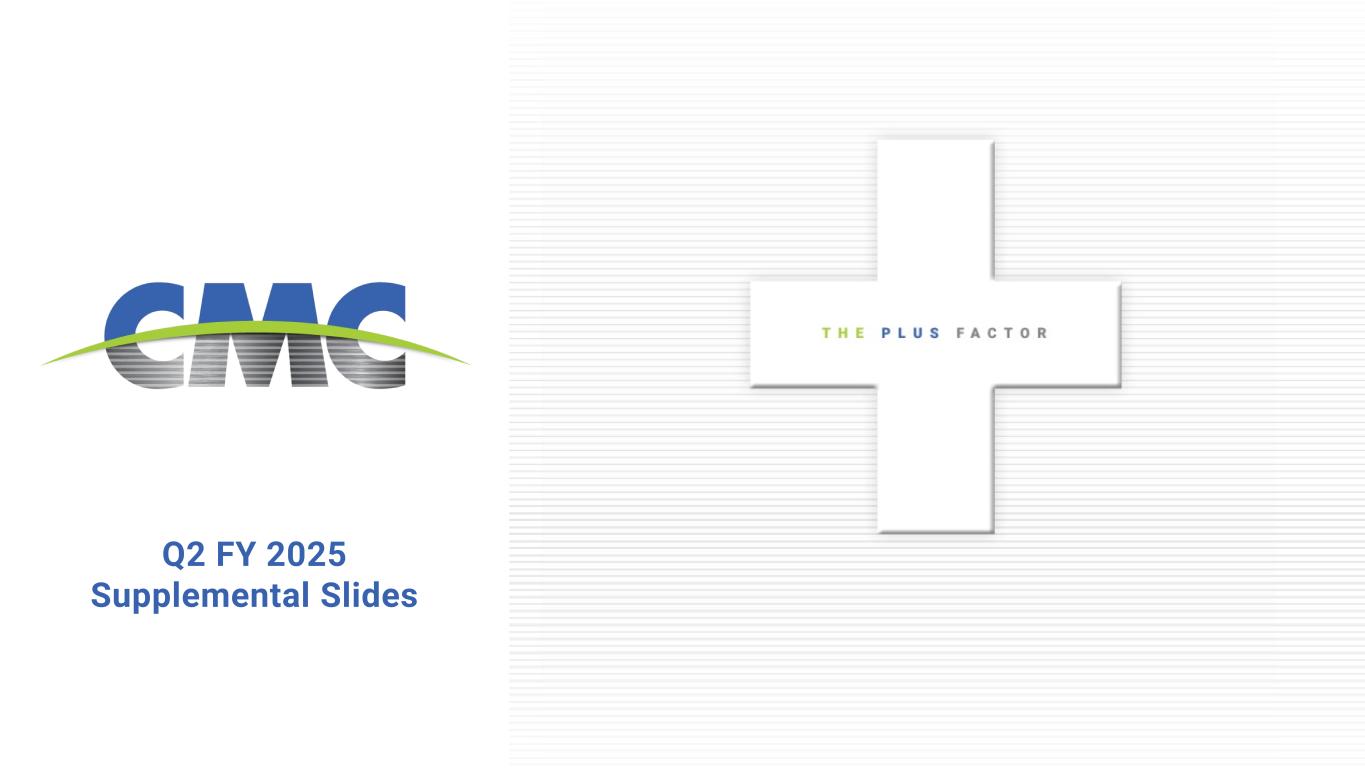
Q2 FY 2025 Supplemental Slides
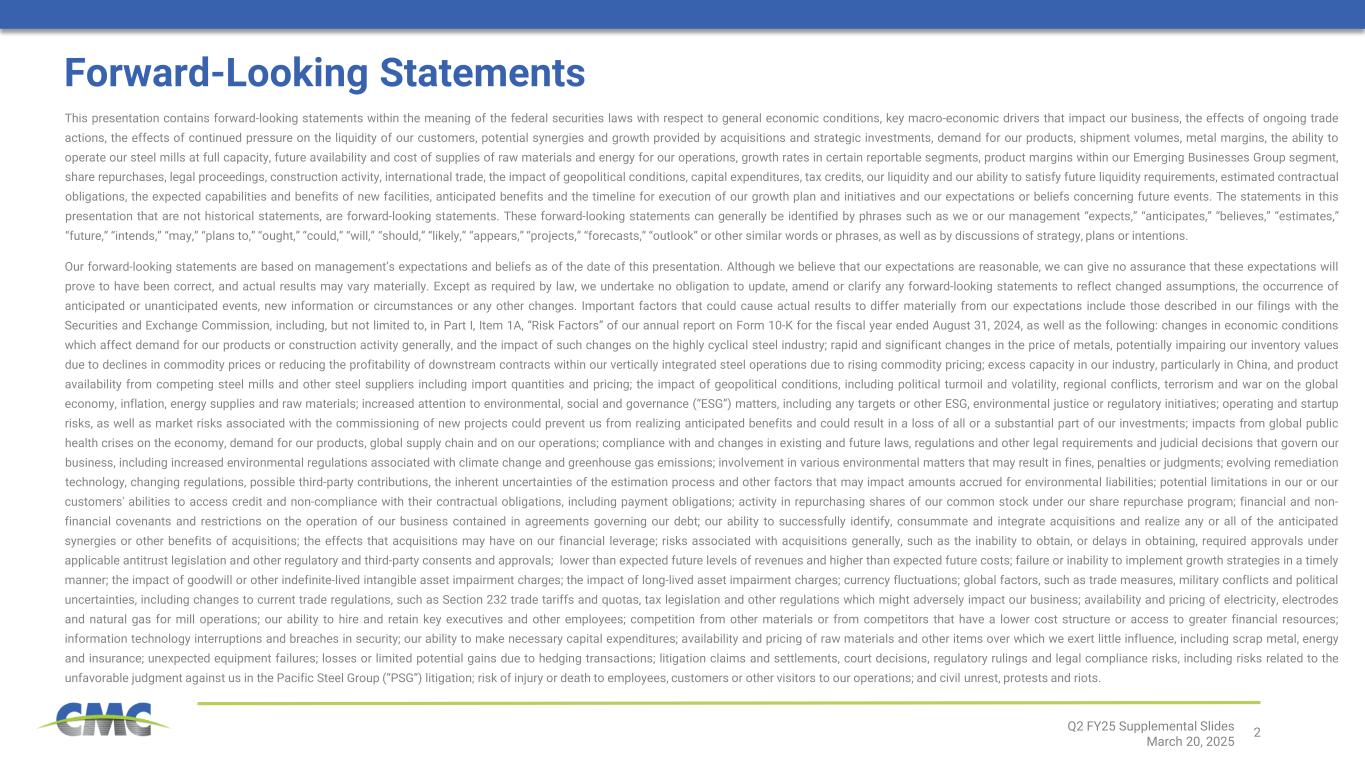
2Q2 FY25 Supplemental Slides March 20, 2025 This presentation contains forward-looking statements within the meaning of the federal securities laws with respect to general economic conditions, key macro-economic drivers that impact our business, the effects of ongoing trade actions, the effects of continued pressure on the liquidity of our customers, potential synergies and growth provided by acquisitions and strategic investments, demand for our products, shipment volumes, metal margins, the ability to operate our steel mills at full capacity, future availability and cost of supplies of raw materials and energy for our operations, growth rates in certain reportable segments, product margins within our Emerging Businesses Group segment, share repurchases, legal proceedings, construction activity, international trade, the impact of geopolitical conditions, capital expenditures, tax credits, our liquidity and our ability to satisfy future liquidity requirements, estimated contractual obligations, the expected capabilities and benefits of new facilities, anticipated benefits and the timeline for execution of our growth plan and initiatives and our expectations or beliefs concerning future events. The statements in this presentation that are not historical statements, are forward-looking statements. These forward-looking statements can generally be identified by phrases such as we or our management “expects,” “anticipates,” “believes,” “estimates,” “future,” “intends,” “may,” “plans to,” “ought,” “could,” “will,” “should,” “likely,” “appears,” “projects,” “forecasts,” “outlook” or other similar words or phrases, as well as by discussions of strategy, plans or intentions. Our forward-looking statements are based on management’s expectations and beliefs as of the date of this presentation. Although we believe that our expectations are reasonable, we can give no assurance that these expectations will prove to have been correct, and actual results may vary materially. Except as required by law, we undertake no obligation to update, amend or clarify any forward-looking statements to reflect changed assumptions, the occurrence of anticipated or unanticipated events, new information or circumstances or any other changes. Important factors that could cause actual results to differ materially from our expectations include those described in our filings with the Securities and Exchange Commission, including, but not limited to, in Part I, Item 1A, “Risk Factors” of our annual report on Form 10-K for the fiscal year ended August 31, 2024, as well as the following: changes in economic conditions which affect demand for our products or construction activity generally, and the impact of such changes on the highly cyclical steel industry; rapid and significant changes in the price of metals, potentially impairing our inventory values due to declines in commodity prices or reducing the profitability of downstream contracts within our vertically integrated steel operations due to rising commodity pricing; excess capacity in our industry, particularly in China, and product availability from competing steel mills and other steel suppliers including import quantities and pricing; the impact of geopolitical conditions, including political turmoil and volatility, regional conflicts, terrorism and war on the global economy, inflation, energy supplies and raw materials; increased attention to environmental, social and governance (“ESG”) matters, including any targets or other ESG, environmental justice or regulatory initiatives; operating and startup risks, as well as market risks associated with the commissioning of new projects could prevent us from realizing anticipated benefits and could result in a loss of all or a substantial part of our investments; impacts from global public health crises on the economy, demand for our products, global supply chain and on our operations; compliance with and changes in existing and future laws, regulations and other legal requirements and judicial decisions that govern our business, including increased environmental regulations associated with climate change and greenhouse gas emissions; involvement in various environmental matters that may result in fines, penalties or judgments; evolving remediation technology, changing regulations, possible third-party contributions, the inherent uncertainties of the estimation process and other factors that may impact amounts accrued for environmental liabilities; potential limitations in our or our customers' abilities to access credit and non-compliance with their contractual obligations, including payment obligations; activity in repurchasing shares of our common stock under our share repurchase program; financial and non- financial covenants and restrictions on the operation of our business contained in agreements governing our debt; our ability to successfully identify, consummate and integrate acquisitions and realize any or all of the anticipated synergies or other benefits of acquisitions; the effects that acquisitions may have on our financial leverage; risks associated with acquisitions generally, such as the inability to obtain, or delays in obtaining, required approvals under applicable antitrust legislation and other regulatory and third-party consents and approvals; lower than expected future levels of revenues and higher than expected future costs; failure or inability to implement growth strategies in a timely manner; the impact of goodwill or other indefinite-lived intangible asset impairment charges; the impact of long-lived asset impairment charges; currency fluctuations; global factors, such as trade measures, military conflicts and political uncertainties, including changes to current trade regulations, such as Section 232 trade tariffs and quotas, tax legislation and other regulations which might adversely impact our business; availability and pricing of electricity, electrodes and natural gas for mill operations; our ability to hire and retain key executives and other employees; competition from other materials or from competitors that have a lower cost structure or access to greater financial resources; information technology interruptions and breaches in security; our ability to make necessary capital expenditures; availability and pricing of raw materials and other items over which we exert little influence, including scrap metal, energy and insurance; unexpected equipment failures; losses or limited potential gains due to hedging transactions; litigation claims and settlements, court decisions, regulatory rulings and legal compliance risks, including risks related to the unfavorable judgment against us in the Pacific Steel Group (“PSG”) litigation; risk of injury or death to employees, customers or other visitors to our operations; and civil unrest, protests and riots. Forward-Looking Statements
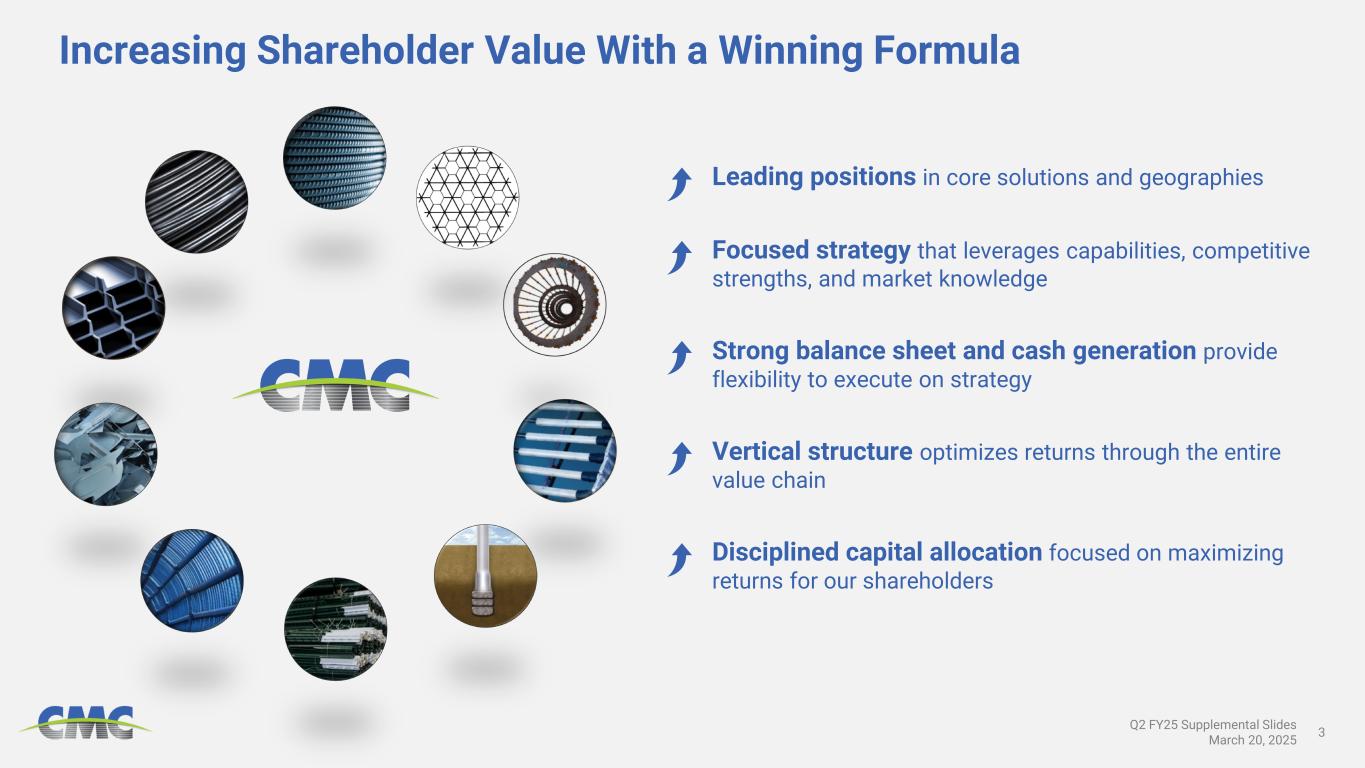
3Q2 FY25 Supplemental Slides March 20, 2025 Leading positions in core solutions and geographies Focused strategy that leverages capabilities, competitive strengths, and market knowledge Strong balance sheet and cash generation provide flexibility to execute on strategy Vertical structure optimizes returns through the entire value chain Disciplined capital allocation focused on maximizing returns for our shareholders Increasing Shareholder Value With a Winning Formula
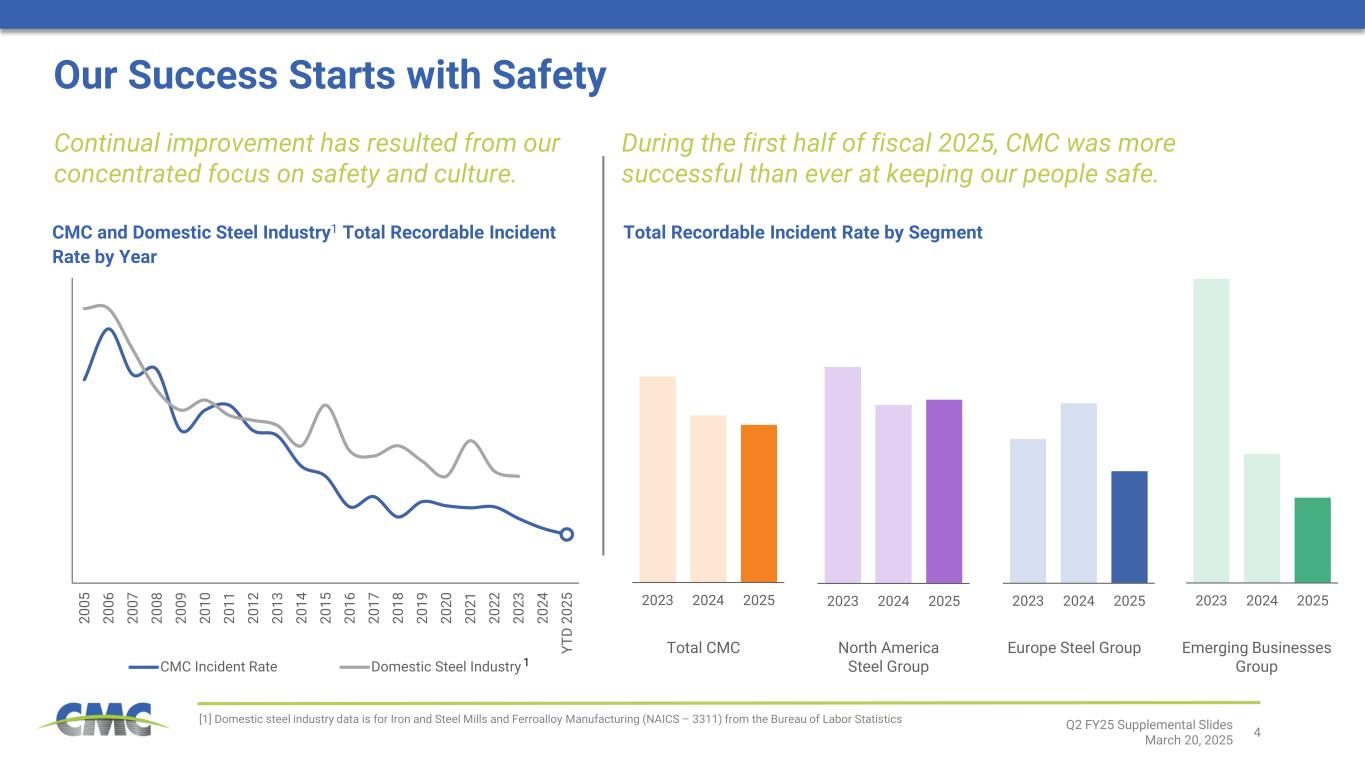
4 20 05 20 06 20 07 20 08 20 09 20 10 20 11 20 12 20 13 20 14 20 15 20 16 20 17 20 18 20 19 20 20 20 21 20 22 20 23 20 24 YT D 20 25 CMC Incident Rate Domestic Steel Industry 1 2023 2024 20252023 2024 20252023 2024 20252023 2024 2025 Our Success Starts with Safety [1] Domestic steel industry data is for Iron and Steel Mills and Ferroalloy Manufacturing (NAICS – 3311) from the Bureau of Labor Statistics CMC and Domestic Steel Industry1 Total Recordable Incident Rate by Year Continual improvement has resulted from our concentrated focus on safety and culture. Total CMC North America Steel Group Europe Steel Group Emerging Businesses Group Total Recordable Incident Rate by Segment During the first half of fiscal 2025, CMC was more successful than ever at keeping our people safe. Q2 FY25 Supplemental Slides March 20, 2025
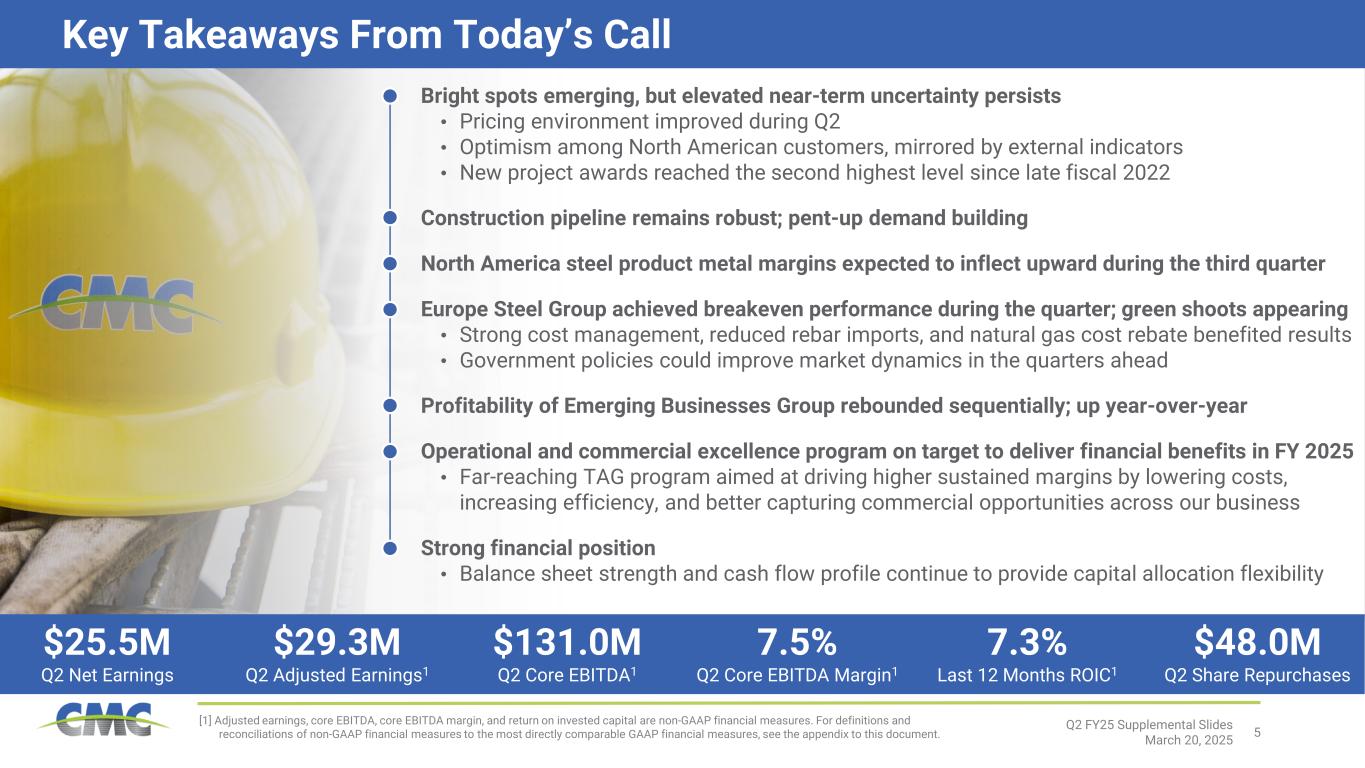
5 Bright spots emerging, but elevated near-term uncertainty persists • Pricing environment improved during Q2 • Optimism among North American customers, mirrored by external indicators • New project awards reached the second highest level since late fiscal 2022 Construction pipeline remains robust; pent-up demand building North America steel product metal margins expected to inflect upward during the third quarter Europe Steel Group achieved breakeven performance during the quarter; green shoots appearing • Strong cost management, reduced rebar imports, and natural gas cost rebate benefited results • Government policies could improve market dynamics in the quarters ahead Profitability of Emerging Businesses Group rebounded sequentially; up year-over-year Operational and commercial excellence program on target to deliver financial benefits in FY 2025 • Far-reaching TAG program aimed at driving higher sustained margins by lowering costs, increasing efficiency, and better capturing commercial opportunities across our business Strong financial position • Balance sheet strength and cash flow profile continue to provide capital allocation flexibility Q2 FY25 Supplemental Slides March 20, 2025 [1] Adjusted earnings, core EBITDA, core EBITDA margin, and return on invested capital are non-GAAP financial measures. For definitions and reconciliations of non-GAAP financial measures to the most directly comparable GAAP financial measures, see the appendix to this document. $25.5M Q2 Net Earnings $29.3M Q2 Adjusted Earnings1 $131.0M Q2 Core EBITDA1 7.5% Q2 Core EBITDA Margin1 7.3% Last 12 Months ROIC1 $48.0M Q2 Share Repurchases Key Takeaways From Today’s Call

6 70 75 80 85 90 95 100 105 110 115 20 30 40 50 60 70 80 Bright Spots Emerging, but Elevated Uncertainty Persists Construction industry sentiment has continued to improve Q2 FY25 Supplemental Slides March 20, 2025 ENR Construction Confidence Index1 Highest level in three years NIFB Small Business Optimism Index3 Mood is favorable among small businesses; large business sentiment is mixed Overall, project owners remain hesitant to commit to new work and are waiting for greater clarity on interest rates and U.S. government policy implementation. Encouragingly, however, downstream contract awards rebounded to the second highest level in nearly three years. Customers appear optimistic about the second half of calendar 2025. Many large infrastructure, energy, manufacturing, and data center projects currently in the planning phase are expected to bid this spring and summer. Significant new multi-year investment programs have been announced over the last few months, totaling well above $1 trillion, focused on AI infrastructure, advanced manufacturing, and energy. [1] Source: Engineering News-Record (ENR) Q1 Construction Index Confidence Index [2] Source: Dodge Construction Network Dodge Momentum Index for January 2025 [3] Source: National Federation of Independent Businesses (NFIB) Small Business Optimism report for January 2025 [4] Source: U.S. Conference Board CEO Confidence Index for Q1 2025 Calendar Quarters Market Observations 50 75 100 125 150 175 200 225 250 Dodge Momentum Index2 Index is at an all-time high with growth in planning broad-based and data centers as a standout Over the last four months, the index has reached its highest levels since late 2020 / early 2021 0 10 20 30 40 50 60 70 80 90 The Conference Board CEO Confidence Index4 The Conference Board’s measure points to growth and investment ahead. Other CEO confidence indices, such as the Business Roundtable and Chief Executive Magazine, are more muted based on tariff concerns Calendar Quarters
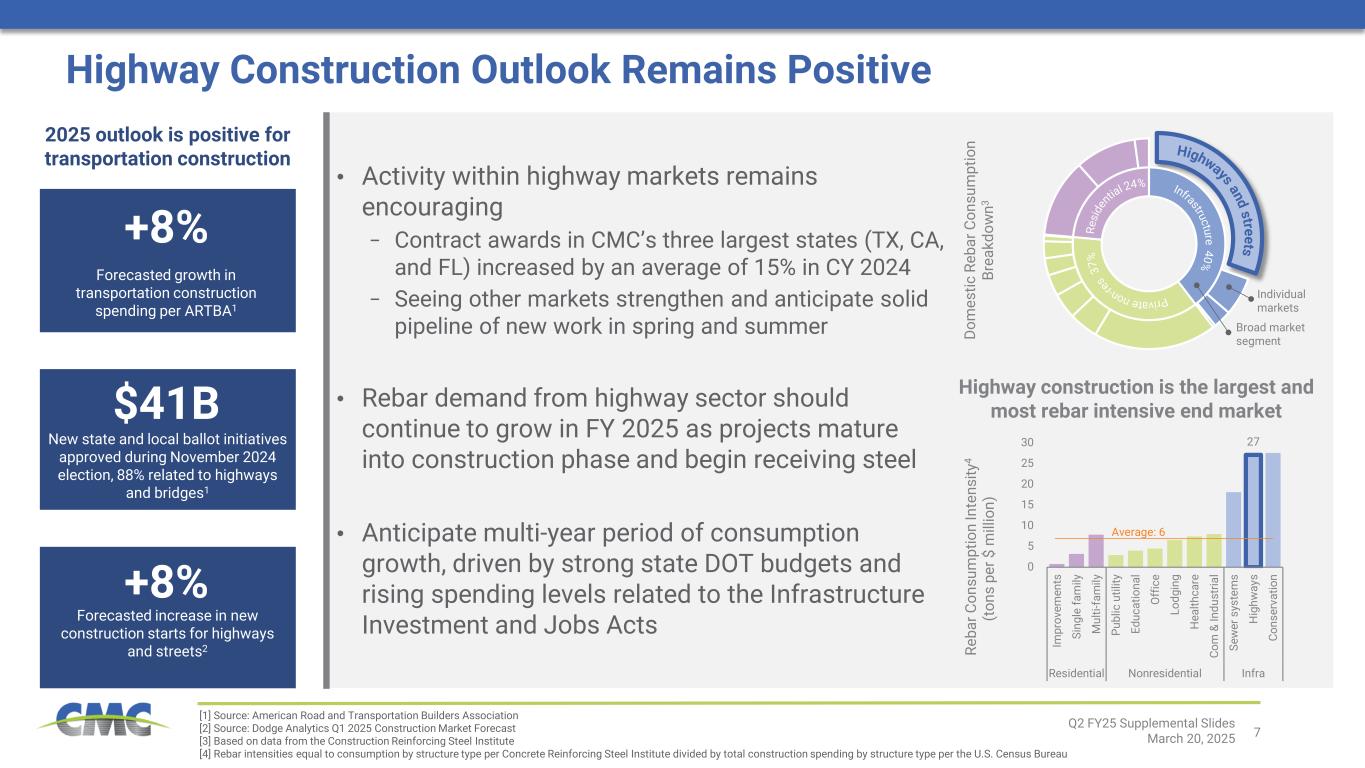
7 Individual markets Broad market segmentDo m es tic R eb ar C on su m pt io n Br ea kd ow n3 Highway Construction Outlook Remains Positive Q2 FY25 Supplemental Slides March 20, 2025 27 0 5 10 15 20 25 30 Im pr ov em en ts Si ng le fa m ily M ul ti- fa m ily Pu bl ic u til ity Ed uc at io na l O ff ic e Lo dg in g H ea lth ca re Co m & In du st ria l Se w er s ys te m s H ig hw ay s Co ns er va tio n Residential Nonresidential Infra Re ba r C on su m pt io n In te ns ity 4 (t on s pe r $ m ill io n) Average: 6 +8% Forecasted growth in transportation construction spending per ARTBA1 $41B New state and local ballot initiatives approved during November 2024 election, 88% related to highways and bridges1 +8% Forecasted increase in new construction starts for highways and streets2 Highway construction is the largest and most rebar intensive end market 2025 outlook is positive for transportation construction [1] Source: American Road and Transportation Builders Association [2] Source: Dodge Analytics Q1 2025 Construction Market Forecast [3] Based on data from the Construction Reinforcing Steel Institute [4] Rebar intensities equal to consumption by structure type per Concrete Reinforcing Steel Institute divided by total construction spending by structure type per the U.S. Census Bureau • Activity within highway markets remains encouraging − Contract awards in CMC’s three largest states (TX, CA, and FL) increased by an average of 15% in CY 2024 − Seeing other markets strengthen and anticipate solid pipeline of new work in spring and summer • Rebar demand from highway sector should continue to grow in FY 2025 as projects mature into construction phase and begin receiving steel • Anticipate multi-year period of consumption growth, driven by strong state DOT budgets and rising spending levels related to the Infrastructure Investment and Jobs Acts
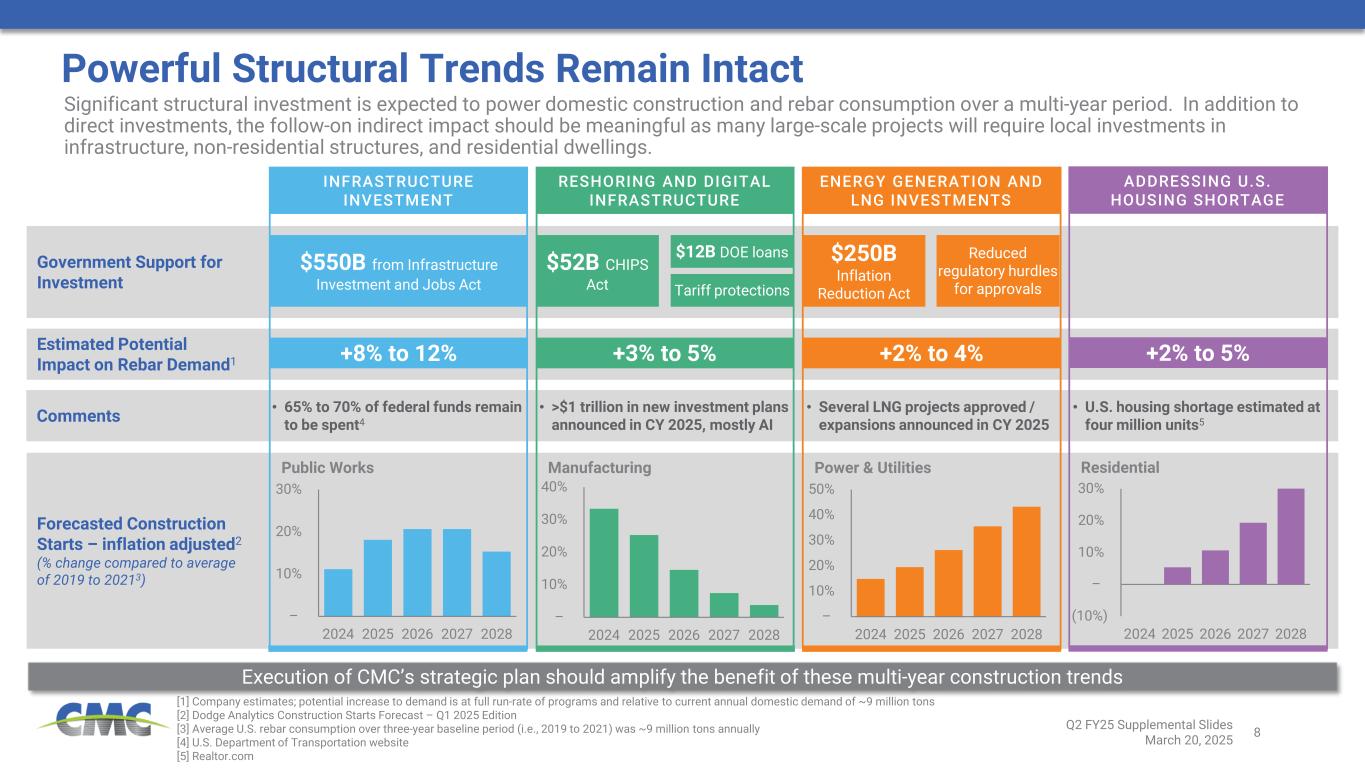
8 Comments Forecasted Construction Starts – inflation adjusted2 (% change compared to average of 2019 to 20213) (10%) – 10% 20% 30% 2024 2025 2026 2027 2028 – 10% 20% 30% 40% 50% 2024 2025 2026 2027 2028 – 10% 20% 30% 40% 2024 2025 2026 2027 2028 – 10% 20% 30% 2024 2025 2026 2027 2028 Estimated Potential Impact on Rebar Demand1 Government Support for Investment Powerful Structural Trends Remain Intact RESHORING AND DIGITAL INFRASTRUCTURE ENERGY GENERATION AND LNG INVESTMENTS Significant structural investment is expected to power domestic construction and rebar consumption over a multi-year period. In addition to direct investments, the follow-on indirect impact should be meaningful as many large-scale projects will require local investments in infrastructure, non-residential structures, and residential dwellings. [1] Company estimates; potential increase to demand is at full run-rate of programs and relative to current annual domestic demand of ~9 million tons [2] Dodge Analytics Construction Starts Forecast – Q1 2025 Edition [3] Average U.S. rebar consumption over three-year baseline period (i.e., 2019 to 2021) was ~9 million tons annually [4] U.S. Department of Transportation website [5] Realtor.com INFRASTRUCTURE INVESTMENT $550B from Infrastructure Investment and Jobs Act $52B CHIPS Act $250B Inflation Reduction Act $12B DOE loans Tariff protections Q2 FY25 Supplemental Slides March 20, 2025 +8% to 12% +3% to 5% +2% to 4% Public Works Manufacturing Power & Utilities Execution of CMC’s strategic plan should amplify the benefit of these multi-year construction trends ADDRESSING U.S. HOUSING SHORTAGE +2% to 5% Residential Reduced regulatory hurdles for approvals • 65% to 70% of federal funds remain to be spent4 • >$1 trillion in new investment plans announced in CY 2025, mostly AI • Several LNG projects approved / expansions announced in CY 2025 • U.S. housing shortage estimated at four million units5
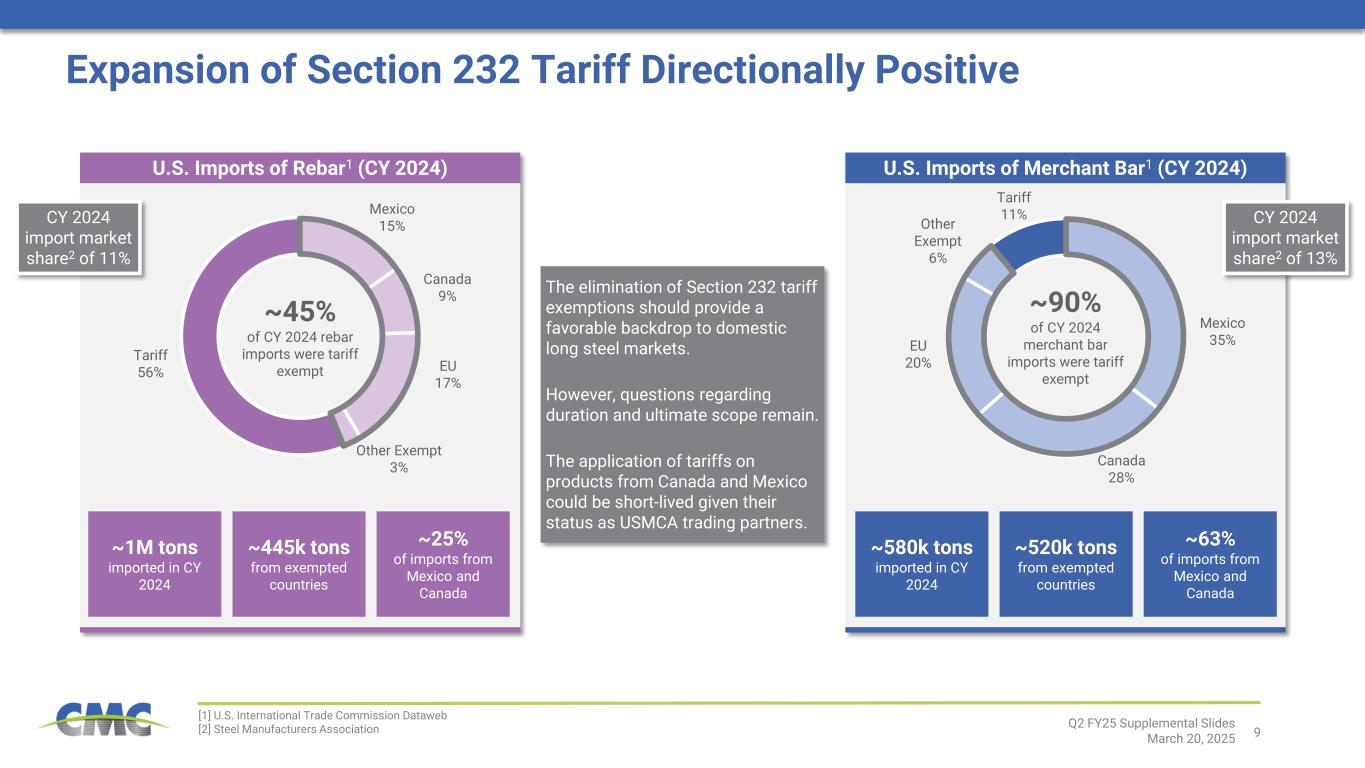
9 Mexico 15% Canada 9% EU 17% Other Exempt 3% Tariff 56% Mexico 35% Canada 28% EU 20% Other Exempt 6% Tariff 11% Expansion of Section 232 Tariff Directionally Positive Q2 FY25 Supplemental Slides March 20, 2025 ~45% of CY 2024 rebar imports were tariff exempt ~90% of CY 2024 merchant bar imports were tariff exempt U.S. Imports of Rebar1 (CY 2024) U.S. Imports of Merchant Bar1 (CY 2024) The elimination of Section 232 tariff exemptions should provide a favorable backdrop to domestic long steel markets. However, questions regarding duration and ultimate scope remain. The application of tariffs on products from Canada and Mexico could be short-lived given their status as USMCA trading partners. CY 2024 import market share2 of 11% CY 2024 import market share2 of 13% ~1M tons imported in CY 2024 ~445k tons from exempted countries ~25% of imports from Mexico and Canada ~580k tons imported in CY 2024 ~520k tons from exempted countries ~63% of imports from Mexico and Canada [1] U.S. International Trade Commission Dataweb [2] Steel Manufacturers Association
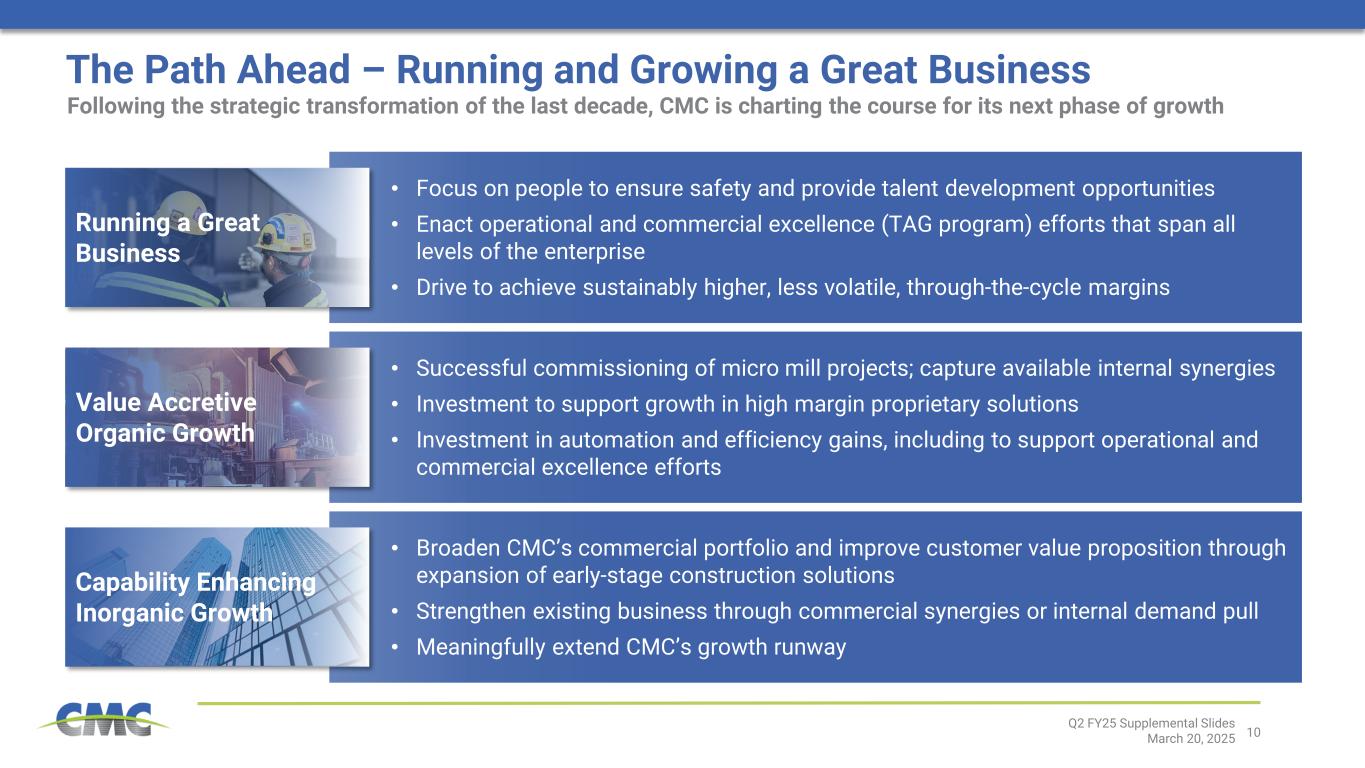
10 The Path Ahead – Running and Growing a Great Business Q2 FY25 Supplemental Slides March 20, 2025 • Focus on people to ensure safety and provide talent development opportunities • Enact operational and commercial excellence (TAG program) efforts that span all levels of the enterprise • Drive to achieve sustainably higher, less volatile, through-the-cycle margins Running a Great Business • Successful commissioning of micro mill projects; capture available internal synergies • Investment to support growth in high margin proprietary solutions • Investment in automation and efficiency gains, including to support operational and commercial excellence efforts Value Accretive Organic Growth • Broaden CMC’s commercial portfolio and improve customer value proposition through expansion of early-stage construction solutions • Strengthen existing business through commercial synergies or internal demand pull • Meaningfully extend CMC’s growth runway Capability Enhancing Inorganic Growth Following the strategic transformation of the last decade, CMC is charting the course for its next phase of growth
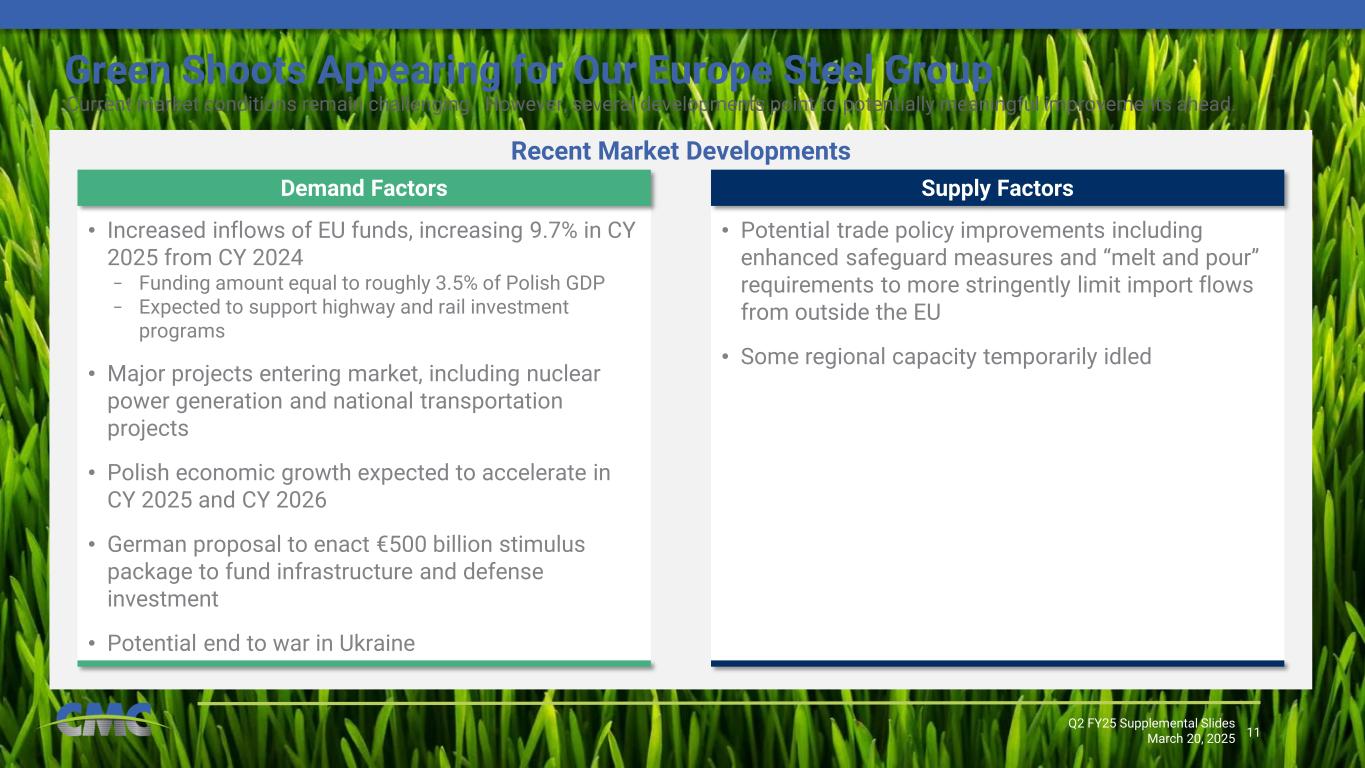
11 Recent Market Developments • Increased inflows of EU funds, increasing 9.7% in CY 2025 from CY 2024 − Funding amount equal to roughly 3.5% of Polish GDP − Expected to support highway and rail investment programs • Major projects entering market, including nuclear power generation and national transportation projects • Polish economic growth expected to accelerate in CY 2025 and CY 2026 • German proposal to enact €500 billion stimulus package to fund infrastructure and defense investment • Potential end to war in Ukraine Green Shoots Appearing for Our Europe Steel Group • Potential trade policy improvements including enhanced safeguard measures and “melt and pour” requirements to more stringently limit import flows from outside the EU • Some regional capacity temporarily idled Current market conditions remain challenging. However, several developments point to potentially meaningful improvements ahead. Demand Factors Supply Factors Q2 FY25 Supplemental Slides March 20, 2025
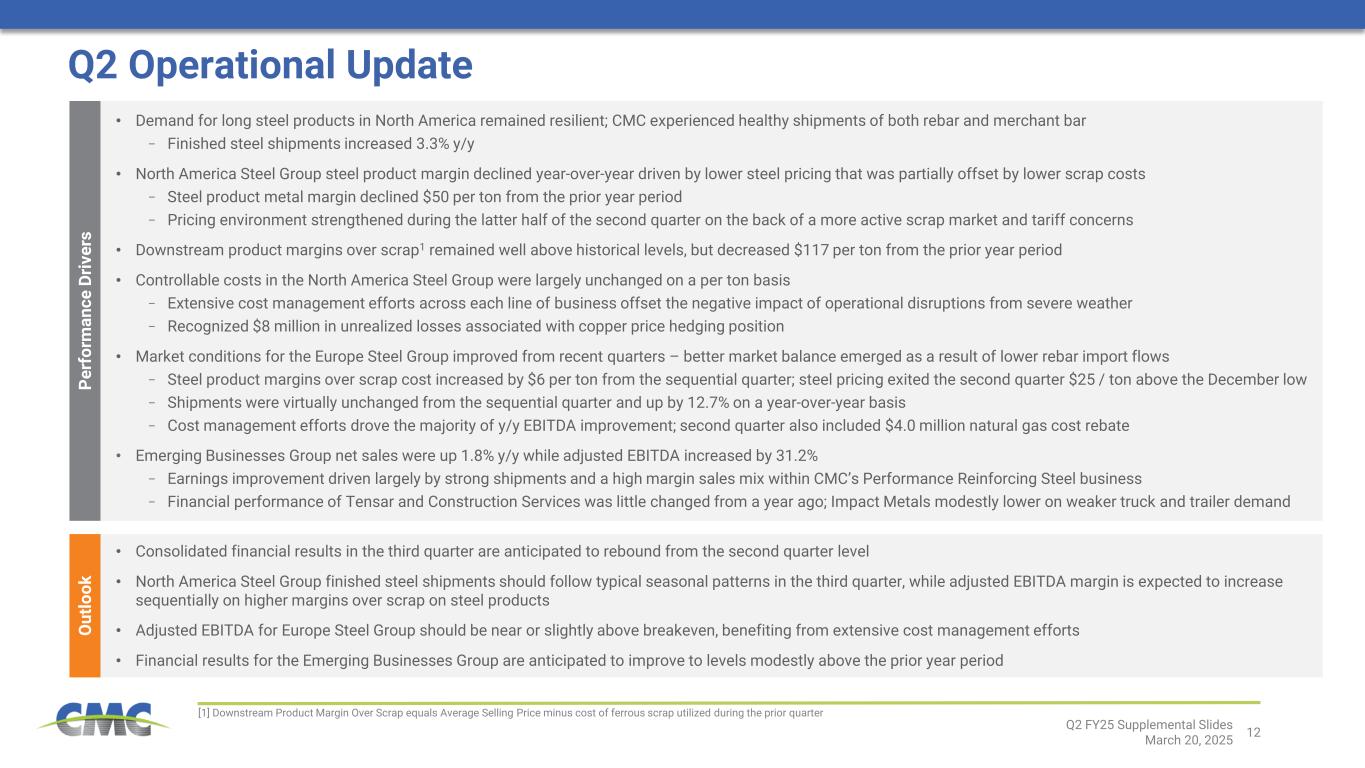
12 • Consolidated financial results in the third quarter are anticipated to rebound from the second quarter level • North America Steel Group finished steel shipments should follow typical seasonal patterns in the third quarter, while adjusted EBITDA margin is expected to increase sequentially on higher margins over scrap on steel products • Adjusted EBITDA for Europe Steel Group should be near or slightly above breakeven, benefiting from extensive cost management efforts • Financial results for the Emerging Businesses Group are anticipated to improve to levels modestly above the prior year period • Demand for long steel products in North America remained resilient; CMC experienced healthy shipments of both rebar and merchant bar − Finished steel shipments increased 3.3% y/y • North America Steel Group steel product margin declined year-over-year driven by lower steel pricing that was partially offset by lower scrap costs − Steel product metal margin declined $50 per ton from the prior year period − Pricing environment strengthened during the latter half of the second quarter on the back of a more active scrap market and tariff concerns • Downstream product margins over scrap1 remained well above historical levels, but decreased $117 per ton from the prior year period • Controllable costs in the North America Steel Group were largely unchanged on a per ton basis − Extensive cost management efforts across each line of business offset the negative impact of operational disruptions from severe weather − Recognized $8 million in unrealized losses associated with copper price hedging position • Market conditions for the Europe Steel Group improved from recent quarters – better market balance emerged as a result of lower rebar import flows − Steel product margins over scrap cost increased by $6 per ton from the sequential quarter; steel pricing exited the second quarter $25 / ton above the December low − Shipments were virtually unchanged from the sequential quarter and up by 12.7% on a year-over-year basis − Cost management efforts drove the majority of y/y EBITDA improvement; second quarter also included $4.0 million natural gas cost rebate • Emerging Businesses Group net sales were up 1.8% y/y while adjusted EBITDA increased by 31.2% − Earnings improvement driven largely by strong shipments and a high margin sales mix within CMC’s Performance Reinforcing Steel business − Financial performance of Tensar and Construction Services was little changed from a year ago; Impact Metals modestly lower on weaker truck and trailer demand Pe rf or m an ce D riv er s O ut lo ok Q2 Operational Update [1] Downstream Product Margin Over Scrap equals Average Selling Price minus cost of ferrous scrap utilized during the prior quarter Q2 FY25 Supplemental Slides March 20, 2025
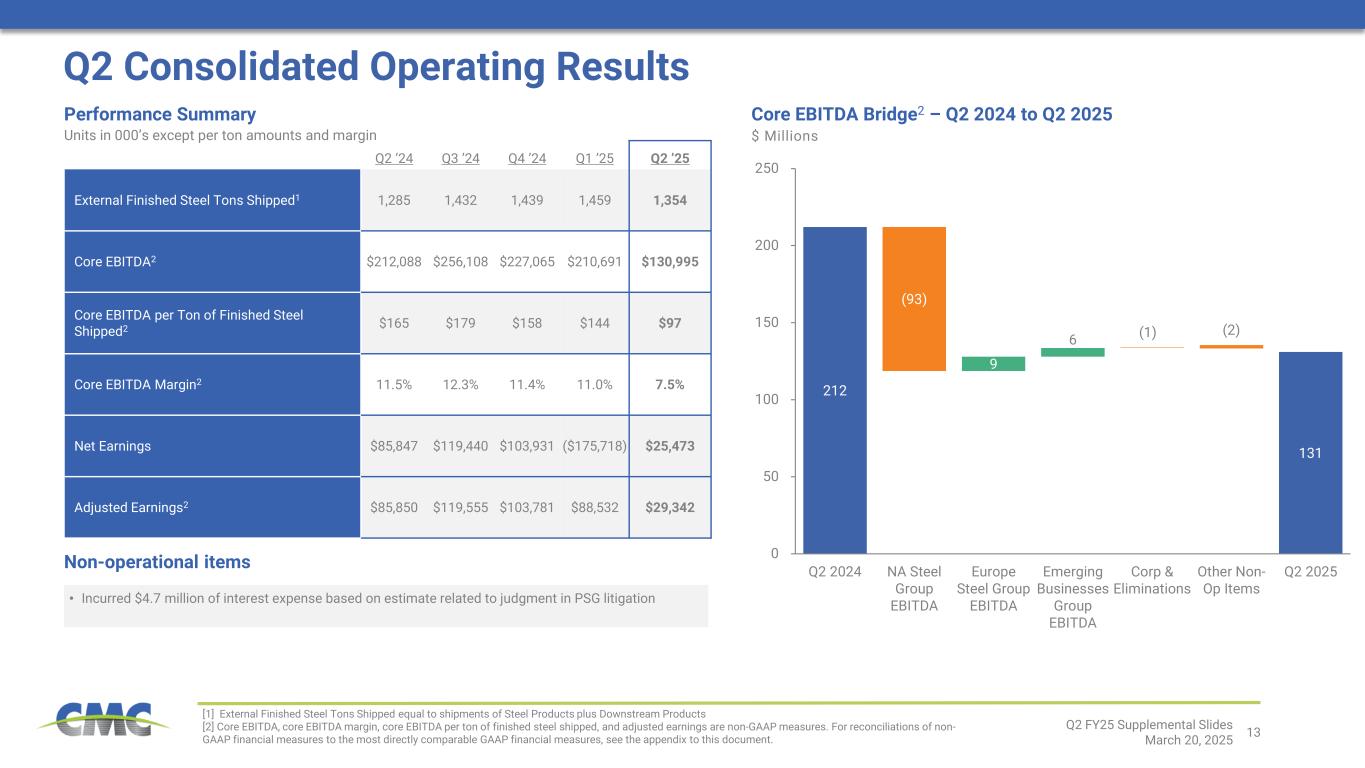
13 212 131 (93) 9 6 (1) (2) 0 50 100 150 200 250 Q2 2024 NA Steel Group EBITDA Europe Steel Group EBITDA Emerging Businesses Group EBITDA Corp & Eliminations Other Non- Op Items Q2 2025 Q2 Consolidated Operating Results Q2 ’24 Q3 ’24 Q4 ’24 Q1 ’25 Q2 ’25 External Finished Steel Tons Shipped1 1,285 1,432 1,439 1,459 1,354 Core EBITDA2 $212,088 $256,108 $227,065 $210,691 $130,995 Core EBITDA per Ton of Finished Steel Shipped2 $165 $179 $158 $144 $97 Core EBITDA Margin2 11.5% 12.3% 11.4% 11.0% 7.5% Net Earnings $85,847 $119,440 $103,931 ($175,718) $25,473 Adjusted Earnings2 $85,850 $119,555 $103,781 $88,532 $29,342 Performance Summary Units in 000’s except per ton amounts and margin • Incurred $4.7 million of interest expense based on estimate related to judgment in PSG litigation Non-operational items [1] External Finished Steel Tons Shipped equal to shipments of Steel Products plus Downstream Products [2] Core EBITDA, core EBITDA margin, core EBITDA per ton of finished steel shipped, and adjusted earnings are non-GAAP measures. For reconciliations of non- GAAP financial measures to the most directly comparable GAAP financial measures, see the appendix to this document. Core EBITDA Bridge2 – Q2 2024 to Q2 2025 $ Millions Q2 FY25 Supplemental Slides March 20, 2025
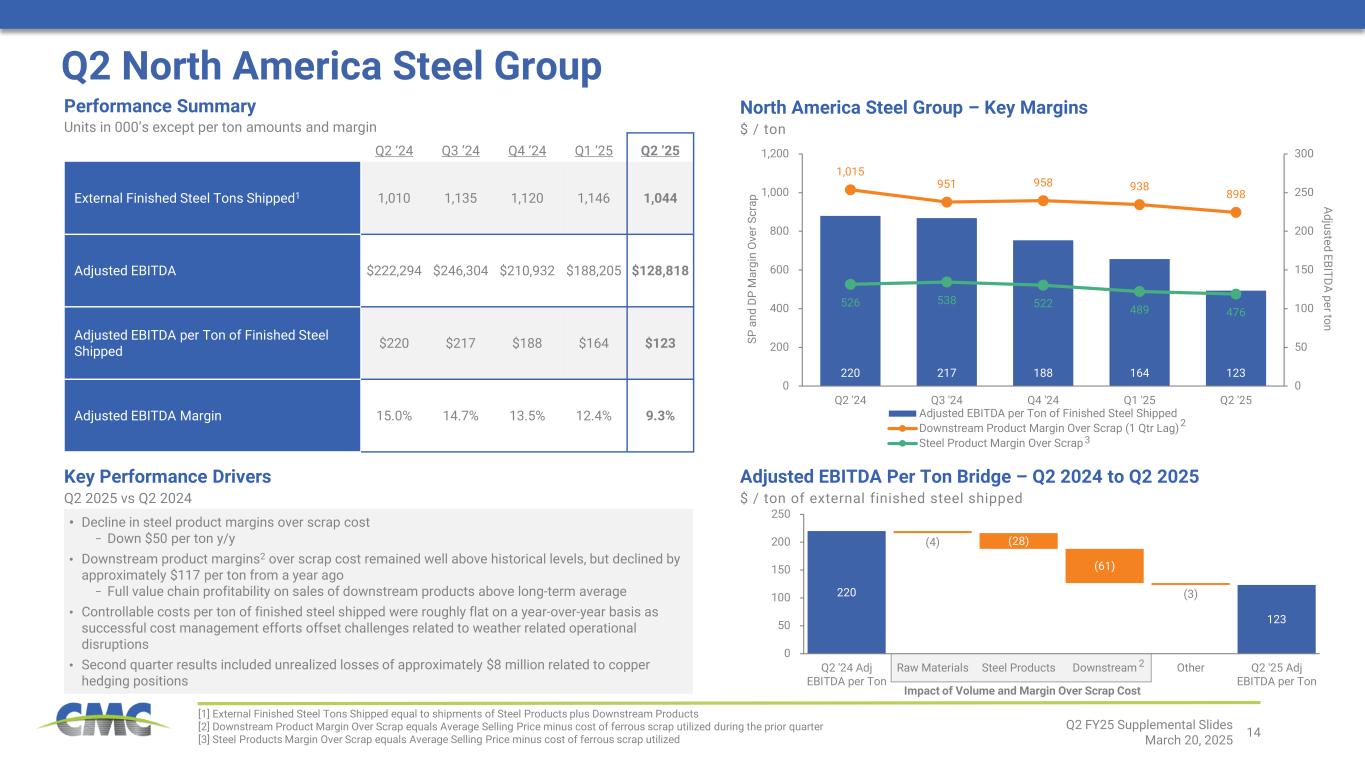
14 220 123 (4) (28) (61) (3) 0 50 100 150 200 250 Q2 '24 Adj EBITDA per Ton Raw Materials Steel Products Downstream Other Q2 '25 Adj EBITDA per Ton 220 217 188 164 123 1,015 951 958 938 898 526 538 522 489 476 0 50 100 150 200 250 300 0 200 400 600 800 1,000 1,200 Q2 '24 Q3 '24 Q4 '24 Q1 '25 Q2 '25 Adjusted EBITDA per Ton of Finished Steel Shipped Downstream Product Margin Over Scrap (1 Qtr Lag) Steel Product Margin Over Scrap Key Performance Drivers Q2 2025 vs Q2 2024 Q2 North America Steel Group Q2 ’24 Q3 ’24 Q4 ’24 Q1 ’25 Q2 ’25 External Finished Steel Tons Shipped1 1,010 1,135 1,120 1,146 1,044 Adjusted EBITDA $222,294 $246,304 $210,932 $188,205 $128,818 Adjusted EBITDA per Ton of Finished Steel Shipped $220 $217 $188 $164 $123 Adjusted EBITDA Margin 15.0% 14.7% 13.5% 12.4% 9.3% Performance Summary Units in 000’s except per ton amounts and margin • Decline in steel product margins over scrap cost − Down $50 per ton y/y • Downstream product margins2 over scrap cost remained well above historical levels, but declined by approximately $117 per ton from a year ago − Full value chain profitability on sales of downstream products above long-term average • Controllable costs per ton of finished steel shipped were roughly flat on a year-over-year basis as successful cost management efforts offset challenges related to weather related operational disruptions • Second quarter results included unrealized losses of approximately $8 million related to copper hedging positions [1] External Finished Steel Tons Shipped equal to shipments of Steel Products plus Downstream Products [2] Downstream Product Margin Over Scrap equals Average Selling Price minus cost of ferrous scrap utilized during the prior quarter [3] Steel Products Margin Over Scrap equals Average Selling Price minus cost of ferrous scrap utilized North America Steel Group – Key Margins $ / ton SP a nd D P M ar gi n O ve r S cr ap Adjusted EBITDA per ton Adjusted EBITDA Per Ton Bridge – Q2 2024 to Q2 2025 $ / ton of external finished steel shipped 2 3 2 Impact of Volume and Margin Over Scrap Cost Q2 FY25 Supplemental Slides March 20, 2025
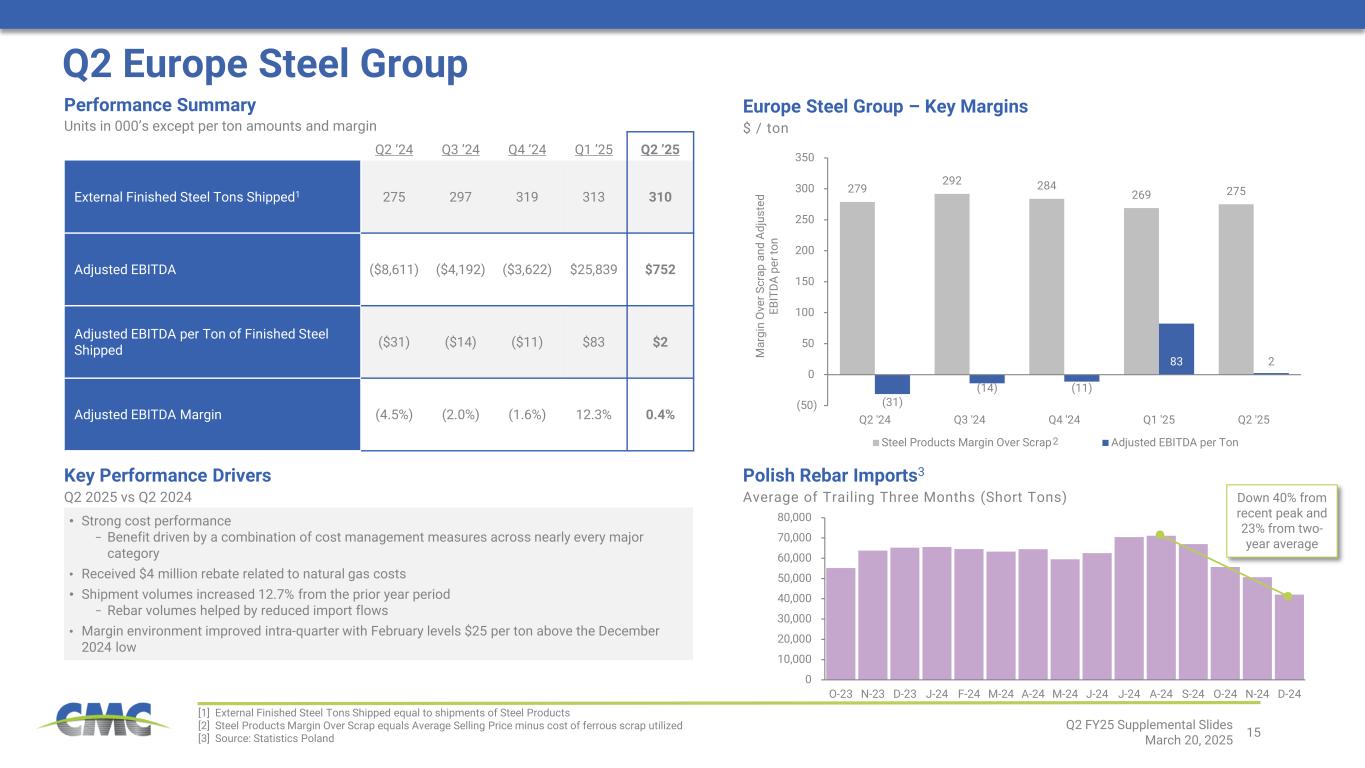
15 0 10,000 20,000 30,000 40,000 50,000 60,000 70,000 80,000 O-23 N-23 D-23 J-24 F-24 M-24 A-24 M-24 J-24 J-24 A-24 S-24 O-24 N-24 D-24 279 292 284 269 275 (31) (14) (11) 83 2 (50) 0 50 100 150 200 250 300 350 Q2 '24 Q3 '24 Q4 '24 Q1 '25 Q2 '25 Steel Products Margin Over Scrap Adjusted EBITDA per Ton Key Performance Drivers Q2 2025 vs Q2 2024 Q2 Europe Steel Group Q2 ’24 Q3 ’24 Q4 ’24 Q1 ’25 Q2 ’25 External Finished Steel Tons Shipped1 275 297 319 313 310 Adjusted EBITDA ($8,611) ($4,192) ($3,622) $25,839 $752 Adjusted EBITDA per Ton of Finished Steel Shipped ($31) ($14) ($11) $83 $2 Adjusted EBITDA Margin (4.5%) (2.0%) (1.6%) 12.3% 0.4% Performance Summary Units in 000’s except per ton amounts and margin • Strong cost performance − Benefit driven by a combination of cost management measures across nearly every major category • Received $4 million rebate related to natural gas costs • Shipment volumes increased 12.7% from the prior year period − Rebar volumes helped by reduced import flows • Margin environment improved intra-quarter with February levels $25 per ton above the December 2024 low Europe Steel Group – Key Margins $ / ton Polish Rebar Imports3 Average of Trailing Three Months (Short Tons) 2 [1] External Finished Steel Tons Shipped equal to shipments of Steel Products [2] Steel Products Margin Over Scrap equals Average Selling Price minus cost of ferrous scrap utilized [3] Source: Statistics Poland M ar gi n O ve r S cr ap a nd A dj us te d EB IT DA p er to n Q2 FY25 Supplemental Slides March 20, 2025 Down 40% from recent peak and 23% from two- year average
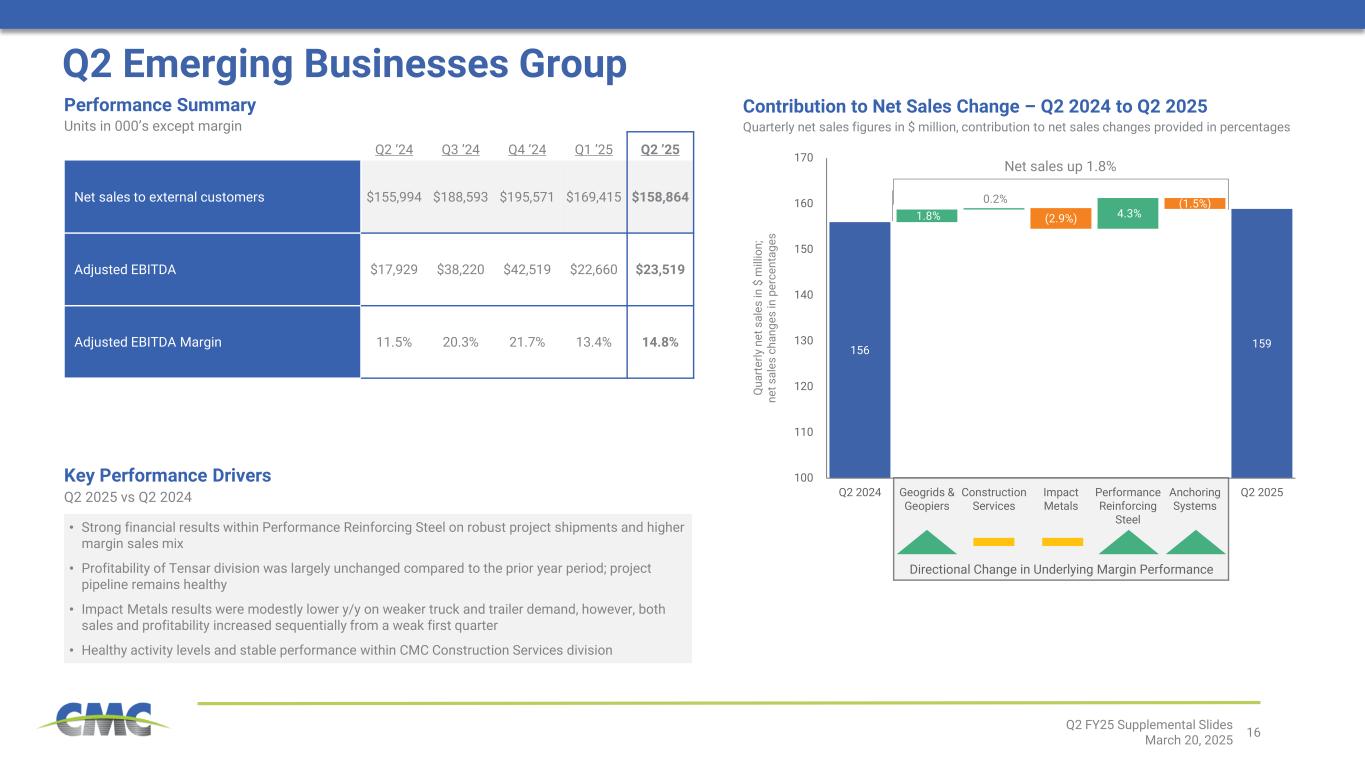
16 156 159 1.8% 0.2% (2.9%) 4.3% (1.5%) 100 110 120 130 140 150 160 170 Q2 2024 Geogrids & Geopiers Construction Services Impact Metals Performance Reinforcing Steel Anchoring Systems Q2 2025 Key Performance Drivers Q2 2025 vs Q2 2024 Q2 Emerging Businesses Group Q2 ’24 Q3 ’24 Q4 ’24 Q1 ’25 Q2 ’25 Net sales to external customers $155,994 $188,593 $195,571 $169,415 $158,864 Adjusted EBITDA $17,929 $38,220 $42,519 $22,660 $23,519 Adjusted EBITDA Margin 11.5% 20.3% 21.7% 13.4% 14.8% Performance Summary Units in 000’s except margin • Strong financial results within Performance Reinforcing Steel on robust project shipments and higher margin sales mix • Profitability of Tensar division was largely unchanged compared to the prior year period; project pipeline remains healthy • Impact Metals results were modestly lower y/y on weaker truck and trailer demand, however, both sales and profitability increased sequentially from a weak first quarter • Healthy activity levels and stable performance within CMC Construction Services division Contribution to Net Sales Change – Q2 2024 to Q2 2025 Quarterly net sales figures in $ million, contribution to net sales changes provided in percentages Q2 FY25 Supplemental Slides March 20, 2025 Q ua rt er ly n et s al es in $ m ill io n; ne t s al es c ha ng es in p er ce nt ag es Net sales up 1.8% Directional Change in Underlying Margin Performance
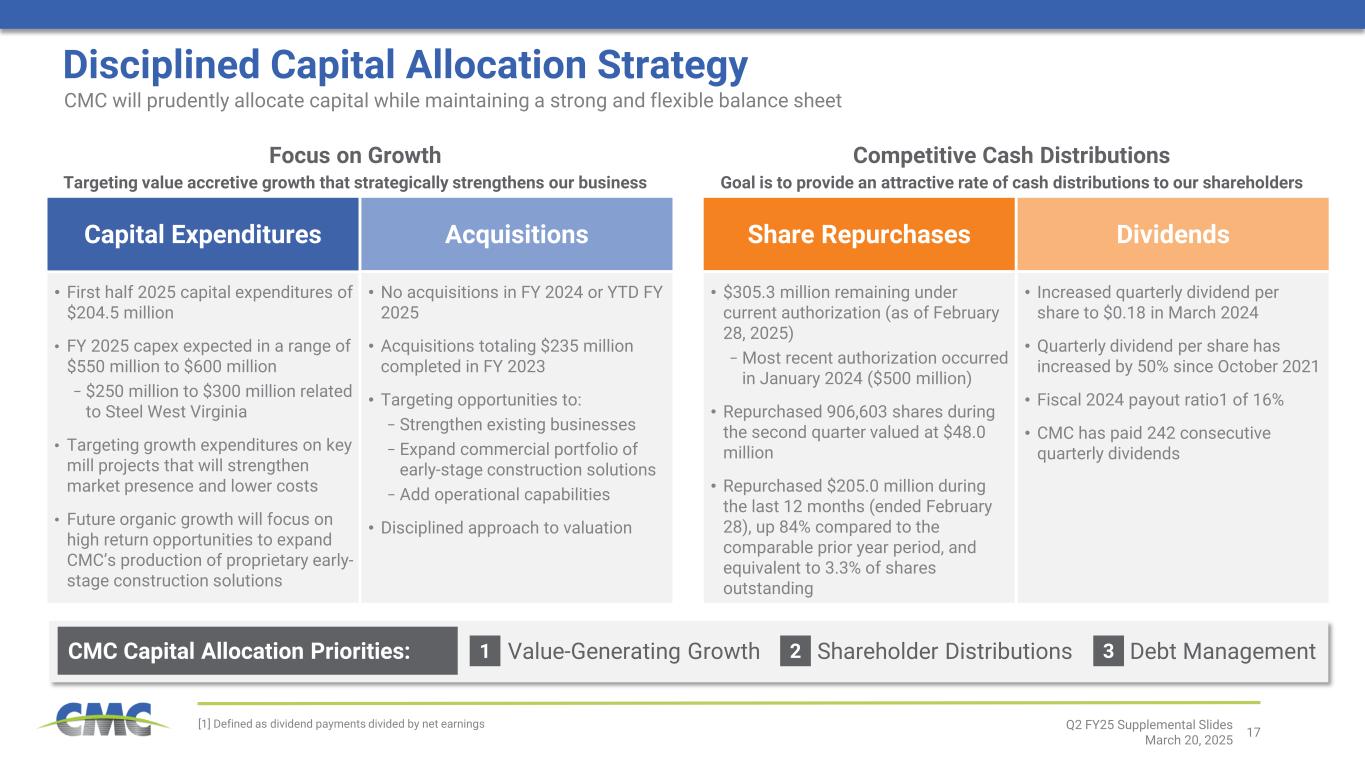
17 • First half 2025 capital expenditures of $204.5 million • FY 2025 capex expected in a range of $550 million to $600 million − $250 million to $300 million related to Steel West Virginia • Targeting growth expenditures on key mill projects that will strengthen market presence and lower costs • Future organic growth will focus on high return opportunities to expand CMC’s production of proprietary early- stage construction solutions Disciplined Capital Allocation Strategy CMC will prudently allocate capital while maintaining a strong and flexible balance sheet Q2 FY25 Supplemental Slides March 20, 2025 [1] Defined as dividend payments divided by net earnings 2 31 Value-Generating Growth Shareholder Distributions Debt ManagementCMC Capital Allocation Priorities: Capital Expenditures Acquisitions Share Repurchases Dividends • No acquisitions in FY 2024 or YTD FY 2025 • Acquisitions totaling $235 million completed in FY 2023 • Targeting opportunities to: − Strengthen existing businesses − Expand commercial portfolio of early-stage construction solutions − Add operational capabilities • Disciplined approach to valuation • $305.3 million remaining under current authorization (as of February 28, 2025) − Most recent authorization occurred in January 2024 ($500 million) • Repurchased 906,603 shares during the second quarter valued at $48.0 million • Repurchased $205.0 million during the last 12 months (ended February 28), up 84% compared to the comparable prior year period, and equivalent to 3.3% of shares outstanding • Increased quarterly dividend per share to $0.18 in March 2024 • Quarterly dividend per share has increased by 50% since October 2021 • Fiscal 2024 payout ratio1 of 16% • CMC has paid 242 consecutive quarterly dividends Focus on Growth Targeting value accretive growth that strategically strengthens our business Competitive Cash Distributions Goal is to provide an attractive rate of cash distributions to our shareholders
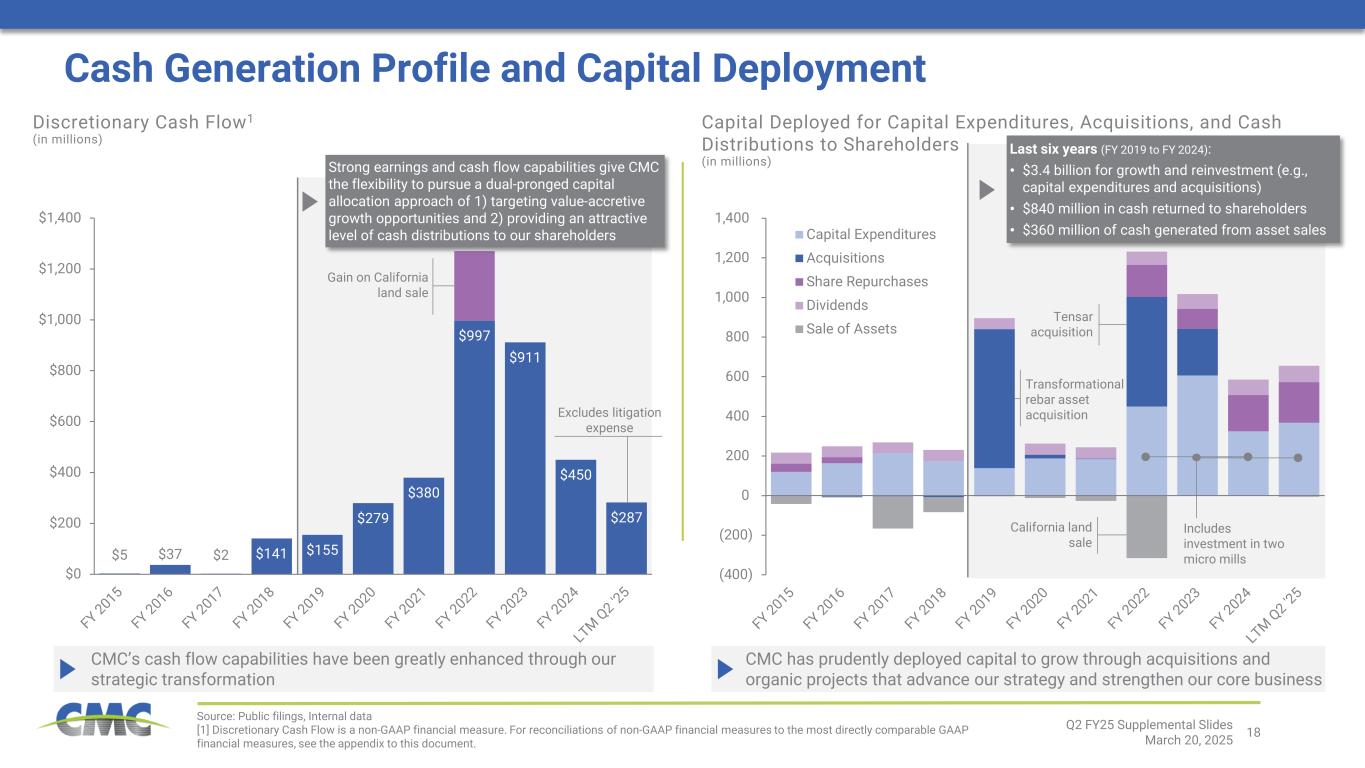
18 Discretionary Cash Flow1 (in millions) Capital Deployed for Capital Expenditures, Acquisitions, and Cash Distributions to Shareholders (in millions) $5 $37 $2 $141 $155 $279 $380 $997 $911 $450 $287 $0 $200 $400 $600 $800 $1,000 $1,200 $1,400 Excludes litigation expense Cash Generation Profile and Capital Deployment Source: Public filings, Internal data [1] Discretionary Cash Flow is a non-GAAP financial measure. For reconciliations of non-GAAP financial measures to the most directly comparable GAAP financial measures, see the appendix to this document. CMC’s cash flow capabilities have been greatly enhanced through our strategic transformation Gain on California land sale Q2 FY25 Supplemental Slides March 20, 2025 Last six years (FY 2019 to FY 2024): • $3.4 billion for growth and reinvestment (e.g., capital expenditures and acquisitions) • $840 million in cash returned to shareholders • $360 million of cash generated from asset sales CMC has prudently deployed capital to grow through acquisitions and organic projects that advance our strategy and strengthen our core business Transformational rebar asset acquisition Tensar acquisition Includes investment in two micro mills California land sale Strong earnings and cash flow capabilities give CMC the flexibility to pursue a dual-pronged capital allocation approach of 1) targeting value-accretive growth opportunities and 2) providing an attractive level of cash distributions to our shareholders (400) (200) 0 200 400 600 800 1,000 1,200 1,400 Capital Expenditures Acquisitions Share Repurchases Dividends Sale of Assets
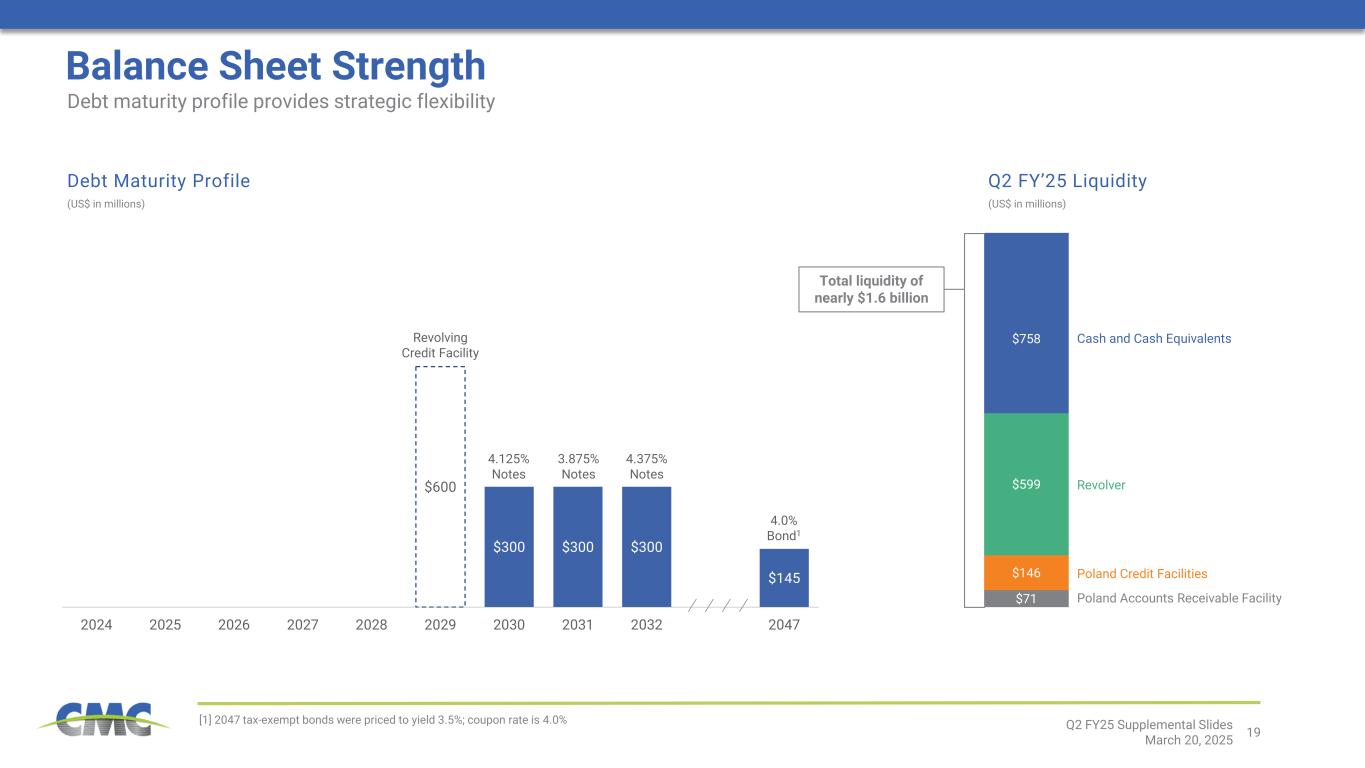
19 $71 $146 $599 $758 $300 $300 $300 $145 $600 2024 2025 2026 2027 2028 2029 2030 2031 2032 2047 Balance Sheet Strength [1] 2047 tax-exempt bonds were priced to yield 3.5%; coupon rate is 4.0% Revolver Poland Credit Facilities (US$ in millions) Revolving Credit Facility 4.125% Notes Cash and Cash Equivalents 3.875% Notes Debt maturity profile provides strategic flexibility Debt Maturity Profile Q2 FY’25 Liquidity (US$ in millions) 4.375% Notes 4.0% Bond1 Poland Accounts Receivable Facility Q2 FY25 Supplemental Slides March 20, 2025 Total liquidity of nearly $1.6 billion
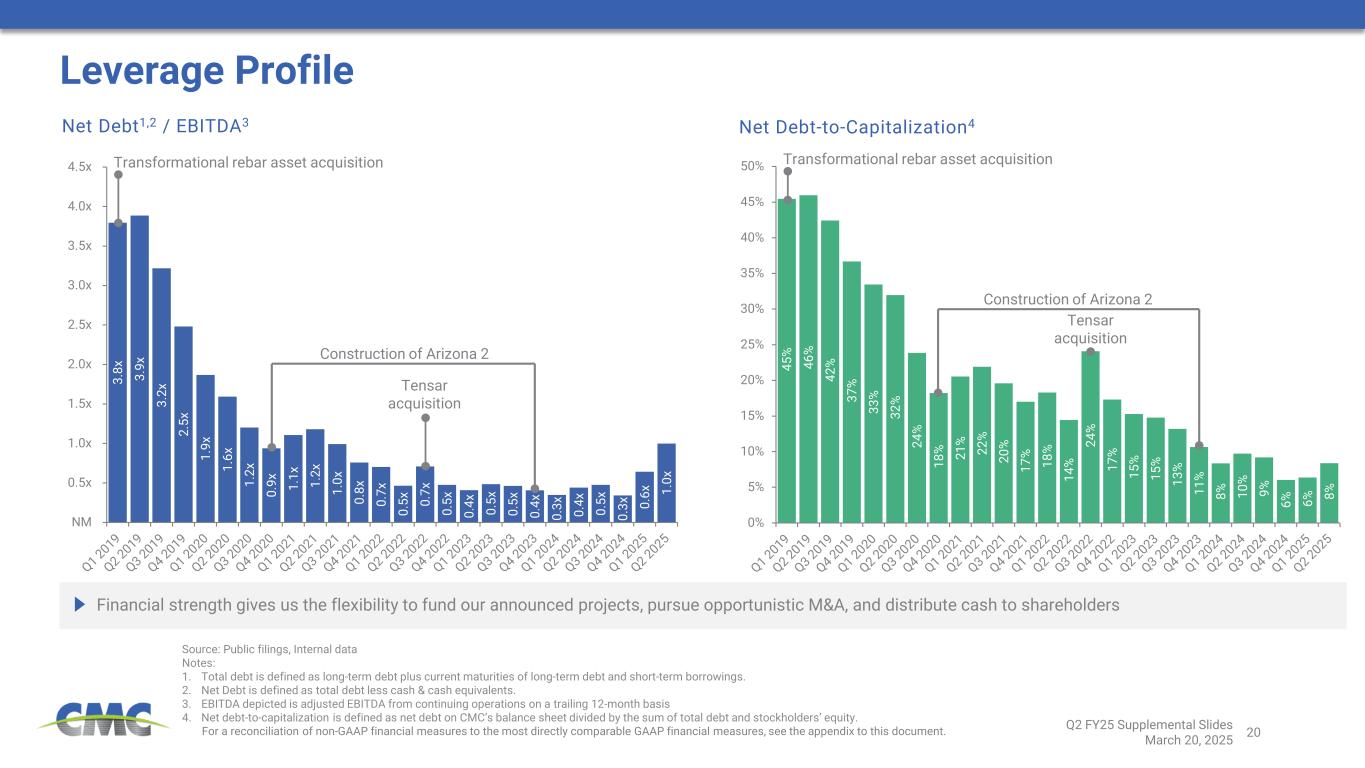
20 45 % 46 % 42 % 37 % 33 % 32 % 24 % 18 % 21 % 22 % 20 % 17 % 18 % 14 % 24 % 17 % 15 % 15 % 13 % 11 % 8% 10 % 9% 6% 6% 8% 0% 5% 10% 15% 20% 25% 30% 35% 40% 45% 50% 3. 8x 3. 9x 3. 2x 2. 5x 1. 9x 1. 6x 1. 2x 0. 9x 1. 1x 1. 2x 1. 0x 0. 8x 0. 7x 0. 5x 0. 7x 0. 5x 0. 4x 0. 5x 0. 5x 0. 4x 0. 3x 0. 4x 0. 5x 0. 3x 0. 6x 1. 0x NM 0.5x 1.0x 1.5x 2.0x 2.5x 3.0x 3.5x 4.0x 4.5x Source: Public filings, Internal data Notes: 1. Total debt is defined as long-term debt plus current maturities of long-term debt and short-term borrowings. 2. Net Debt is defined as total debt less cash & cash equivalents. 3. EBITDA depicted is adjusted EBITDA from continuing operations on a trailing 12-month basis 4. Net debt-to-capitalization is defined as net debt on CMC’s balance sheet divided by the sum of total debt and stockholders’ equity. For a reconciliation of non-GAAP financial measures to the most directly comparable GAAP financial measures, see the appendix to this document. Leverage Profile Financial strength gives us the flexibility to fund our announced projects, pursue opportunistic M&A, and distribute cash to shareholders Net Debt1,2 / EBITDA3 Net Debt-to-Capitalization4 Transformational rebar asset acquisition Tensar acquisition Construction of Arizona 2 Transformational rebar asset acquisition Tensar acquisition Construction of Arizona 2 Q2 FY25 Supplemental Slides March 20, 2025
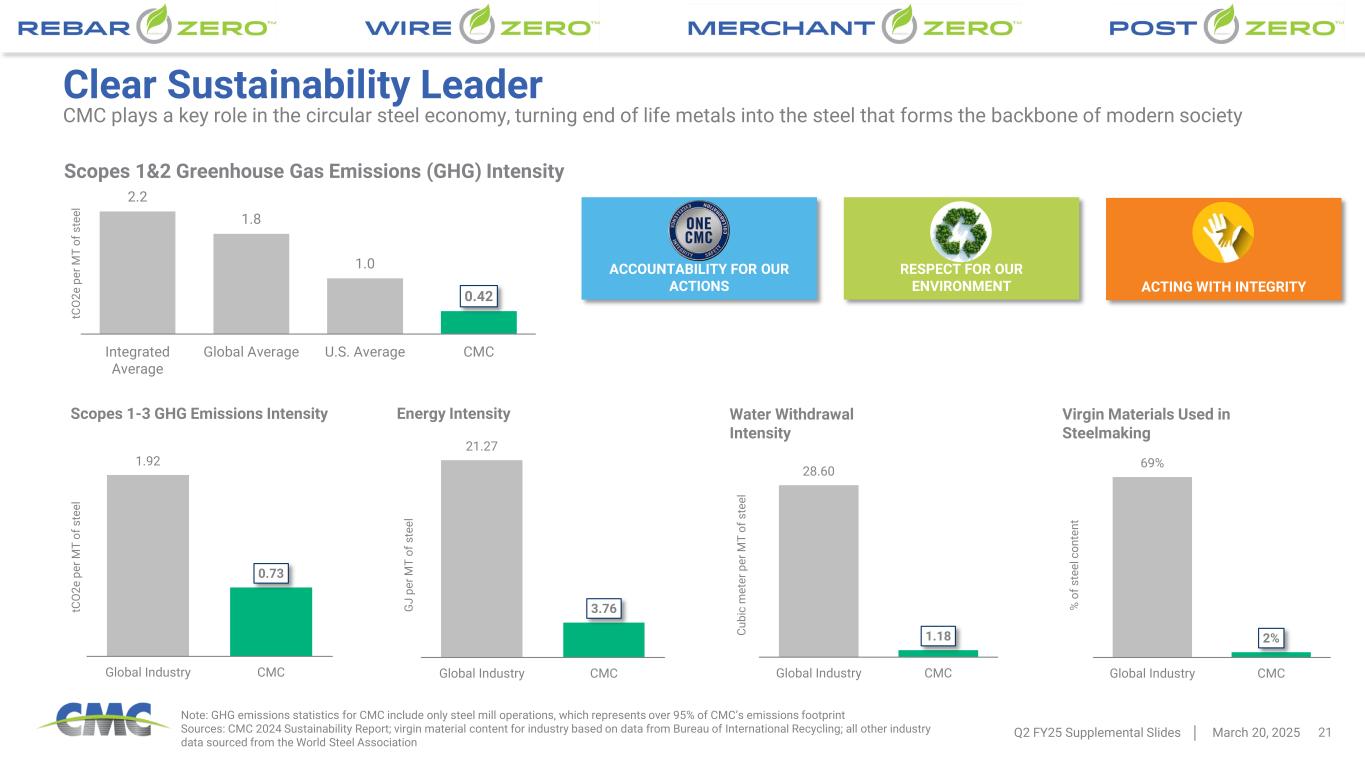
1.18 28.60 CMCGlobal Industry 3.76 21.27 CMCGlobal Industry 0.73 1.92 CMCGlobal Industry Clear Sustainability Leader Q2 FY25 Supplemental Slides │ March 20, 2025 21 Note: GHG emissions statistics for CMC include only steel mill operations, which represents over 95% of CMC’s emissions footprint Sources: CMC 2024 Sustainability Report; virgin material content for industry based on data from Bureau of International Recycling; all other industry data sourced from the World Steel Association CMC plays a key role in the circular steel economy, turning end of life metals into the steel that forms the backbone of modern society ACCOUNTABILITY FOR OUR ACTIONS RESPECT FOR OUR ENVIRONMENT ACTING WITH INTEGRITY 2.2 1.8 1.0 0.42 Integrated Average Global Average U.S. Average CMC Scopes 1&2 Greenhouse Gas Emissions (GHG) Intensity tC O 2e p er M T of s te el Energy Intensity G J pe r M T of s te el Water Withdrawal Intensity Cu bi c m et er p er M T of s te el 2% 69% CMCGlobal Industry Virgin Materials Used in Steelmaking % o f s te el c on te nt Scopes 1-3 GHG Emissions Intensity tC O 2e p er M T of s te el
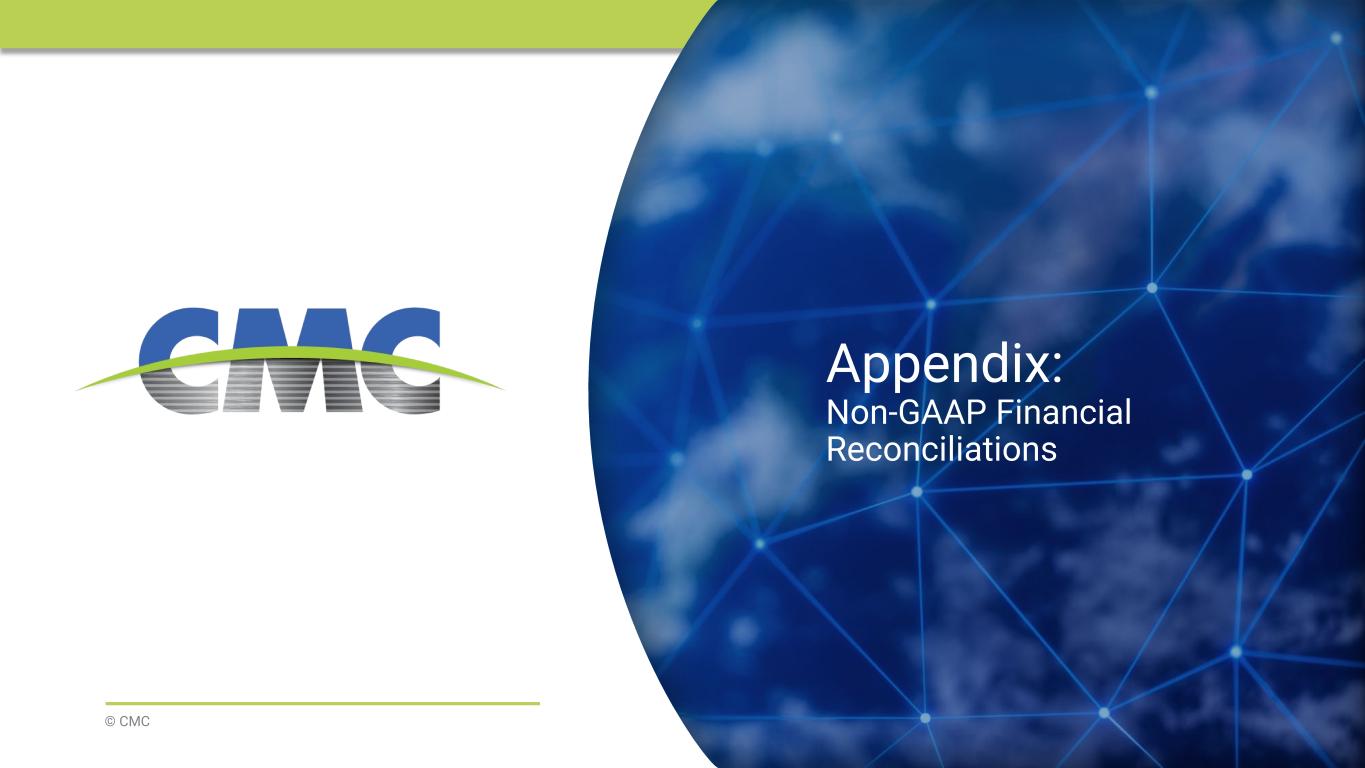
© CMC Appendix: Non-GAAP Financial Reconciliations
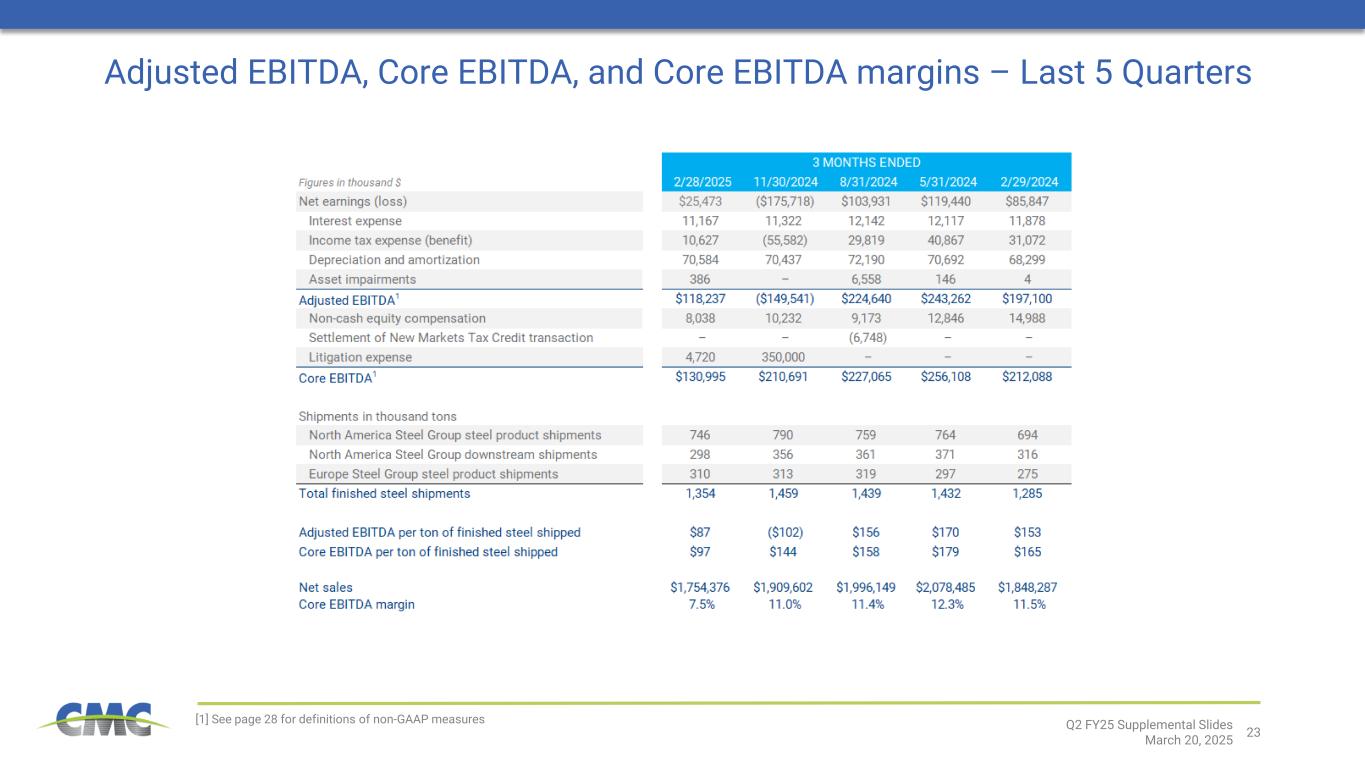
23 Adjusted EBITDA, Core EBITDA, and Core EBITDA margins – Last 5 Quarters [1] See page 28 for definitions of non-GAAP measures Q2 FY25 Supplemental Slides March 20, 2025
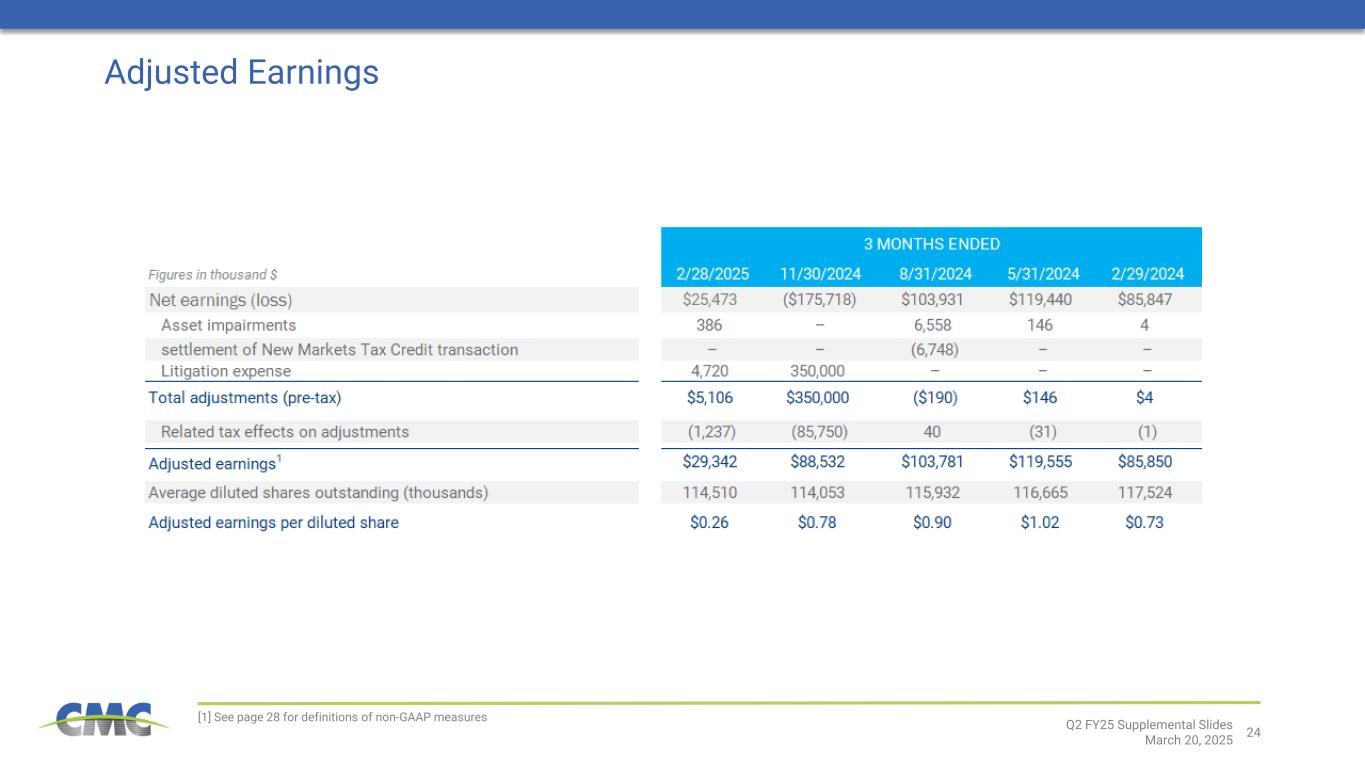
24 Adjusted Earnings [1] See page 28 for definitions of non-GAAP measures Q2 FY25 Supplemental Slides March 20, 2025
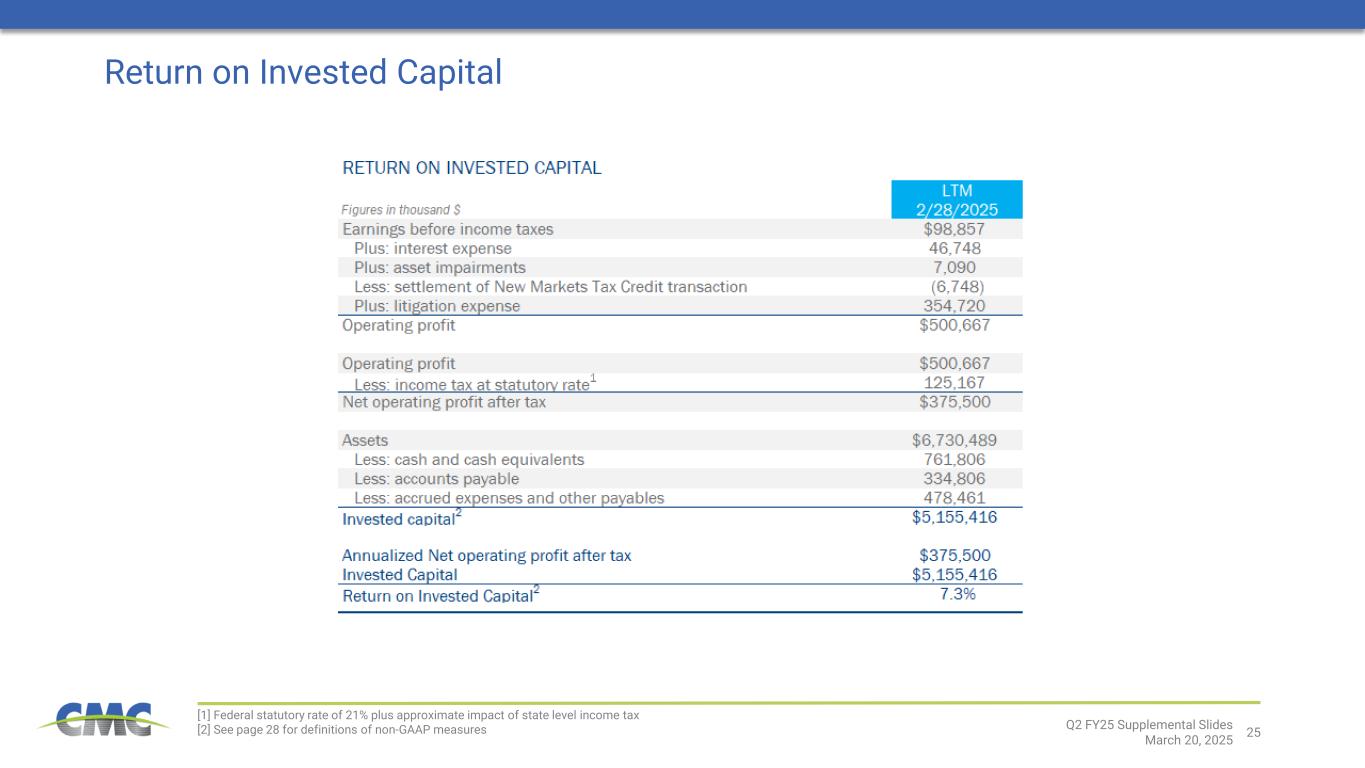
25 Return on Invested Capital [1] Federal statutory rate of 21% plus approximate impact of state level income tax [2] See page 28 for definitions of non-GAAP measures Q2 FY25 Supplemental Slides March 20, 2025
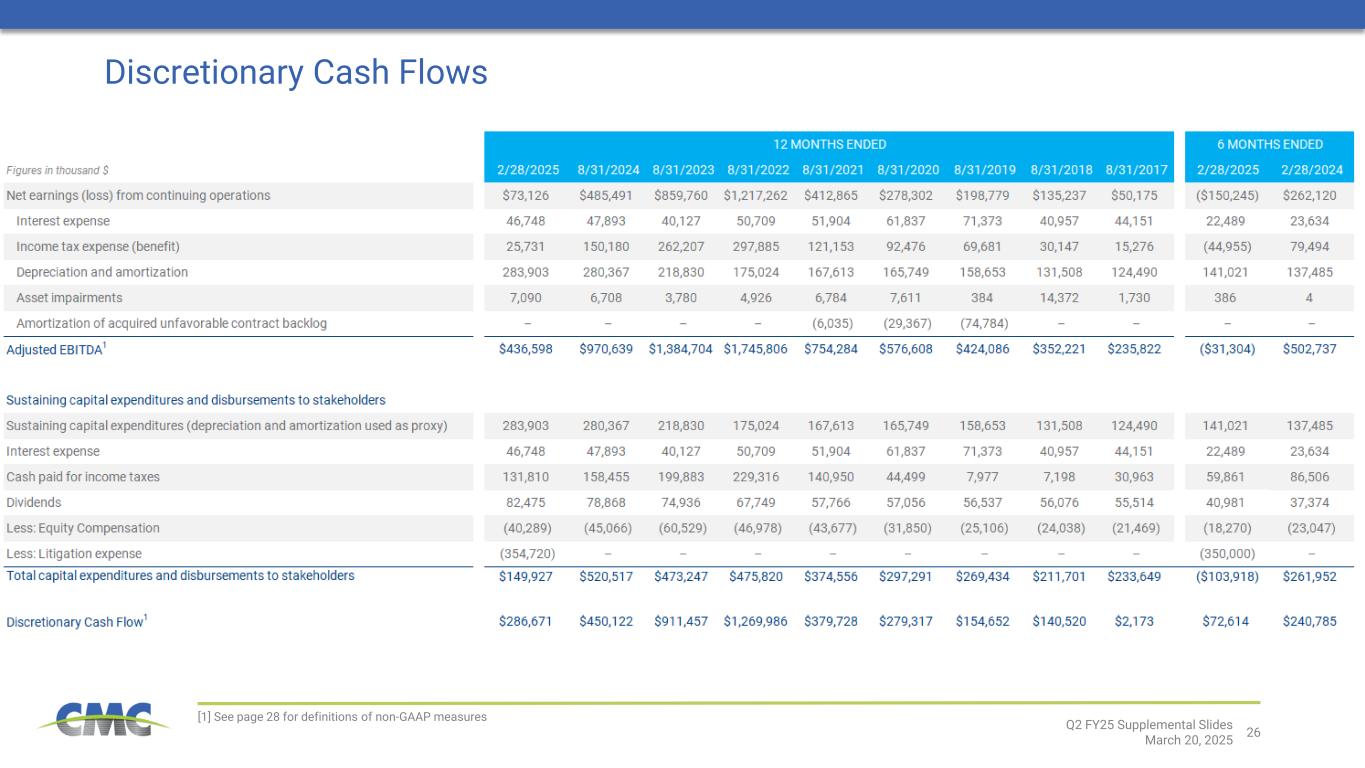
26 [1] See page 28 for definitions of non-GAAP measures Discretionary Cash Flows Q2 FY25 Supplemental Slides March 20, 2025
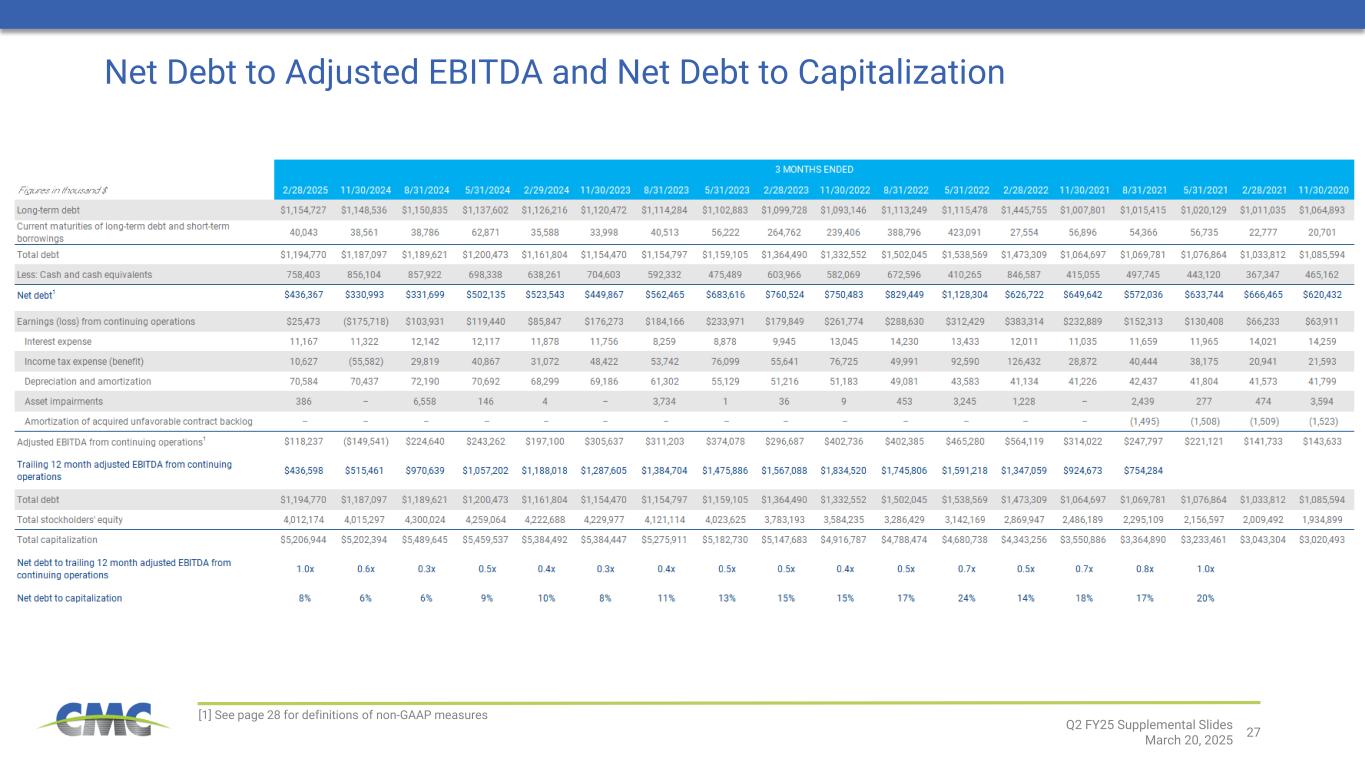
27 Net Debt to Adjusted EBITDA and Net Debt to Capitalization [1] See page 28 for definitions of non-GAAP measures Q2 FY25 Supplemental Slides March 20, 2025
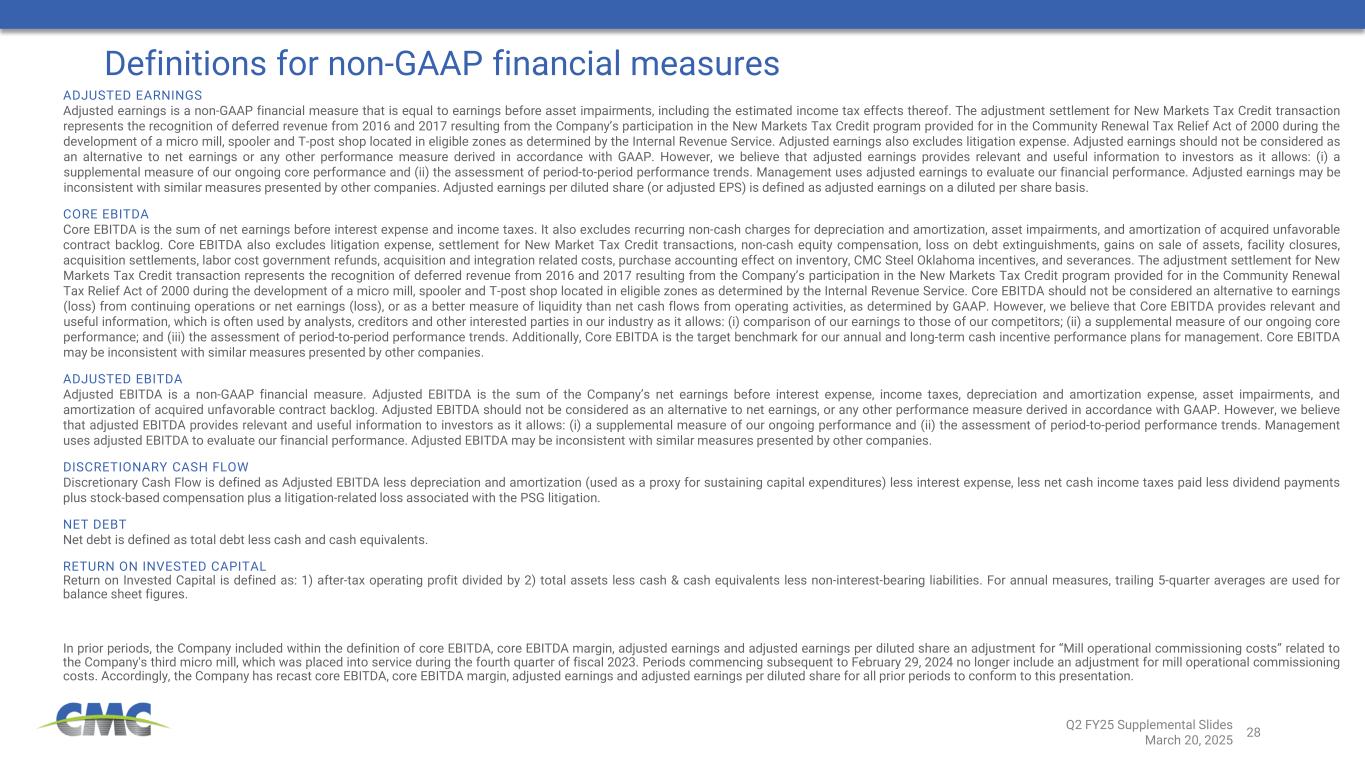
28 Definitions for non-GAAP financial measures ADJUSTED EARNINGS Adjusted earnings is a non-GAAP financial measure that is equal to earnings before asset impairments, including the estimated income tax effects thereof. The adjustment settlement for New Markets Tax Credit transaction represents the recognition of deferred revenue from 2016 and 2017 resulting from the Company’s participation in the New Markets Tax Credit program provided for in the Community Renewal Tax Relief Act of 2000 during the development of a micro mill, spooler and T-post shop located in eligible zones as determined by the Internal Revenue Service. Adjusted earnings also excludes litigation expense. Adjusted earnings should not be considered as an alternative to net earnings or any other performance measure derived in accordance with GAAP. However, we believe that adjusted earnings provides relevant and useful information to investors as it allows: (i) a supplemental measure of our ongoing core performance and (ii) the assessment of period-to-period performance trends. Management uses adjusted earnings to evaluate our financial performance. Adjusted earnings may be inconsistent with similar measures presented by other companies. Adjusted earnings per diluted share (or adjusted EPS) is defined as adjusted earnings on a diluted per share basis. CORE EBITDA Core EBITDA is the sum of net earnings before interest expense and income taxes. It also excludes recurring non-cash charges for depreciation and amortization, asset impairments, and amortization of acquired unfavorable contract backlog. Core EBITDA also excludes litigation expense, settlement for New Market Tax Credit transactions, non-cash equity compensation, loss on debt extinguishments, gains on sale of assets, facility closures, acquisition settlements, labor cost government refunds, acquisition and integration related costs, purchase accounting effect on inventory, CMC Steel Oklahoma incentives, and severances. The adjustment settlement for New Markets Tax Credit transaction represents the recognition of deferred revenue from 2016 and 2017 resulting from the Company’s participation in the New Markets Tax Credit program provided for in the Community Renewal Tax Relief Act of 2000 during the development of a micro mill, spooler and T-post shop located in eligible zones as determined by the Internal Revenue Service. Core EBITDA should not be considered an alternative to earnings (loss) from continuing operations or net earnings (loss), or as a better measure of liquidity than net cash flows from operating activities, as determined by GAAP. However, we believe that Core EBITDA provides relevant and useful information, which is often used by analysts, creditors and other interested parties in our industry as it allows: (i) comparison of our earnings to those of our competitors; (ii) a supplemental measure of our ongoing core performance; and (iii) the assessment of period-to-period performance trends. Additionally, Core EBITDA is the target benchmark for our annual and long-term cash incentive performance plans for management. Core EBITDA may be inconsistent with similar measures presented by other companies. ADJUSTED EBITDA Adjusted EBITDA is a non-GAAP financial measure. Adjusted EBITDA is the sum of the Company’s net earnings before interest expense, income taxes, depreciation and amortization expense, asset impairments, and amortization of acquired unfavorable contract backlog. Adjusted EBITDA should not be considered as an alternative to net earnings, or any other performance measure derived in accordance with GAAP. However, we believe that adjusted EBITDA provides relevant and useful information to investors as it allows: (i) a supplemental measure of our ongoing performance and (ii) the assessment of period-to-period performance trends. Management uses adjusted EBITDA to evaluate our financial performance. Adjusted EBITDA may be inconsistent with similar measures presented by other companies. DISCRETIONARY CASH FLOW Discretionary Cash Flow is defined as Adjusted EBITDA less depreciation and amortization (used as a proxy for sustaining capital expenditures) less interest expense, less net cash income taxes paid less dividend payments plus stock-based compensation plus a litigation-related loss associated with the PSG litigation. NET DEBT Net debt is defined as total debt less cash and cash equivalents. RETURN ON INVESTED CAPITAL Return on Invested Capital is defined as: 1) after-tax operating profit divided by 2) total assets less cash & cash equivalents less non-interest-bearing liabilities. For annual measures, trailing 5-quarter averages are used for balance sheet figures. In prior periods, the Company included within the definition of core EBITDA, core EBITDA margin, adjusted earnings and adjusted earnings per diluted share an adjustment for “Mill operational commissioning costs” related to the Company's third micro mill, which was placed into service during the fourth quarter of fiscal 2023. Periods commencing subsequent to February 29, 2024 no longer include an adjustment for mill operational commissioning costs. Accordingly, the Company has recast core EBITDA, core EBITDA margin, adjusted earnings and adjusted earnings per diluted share for all prior periods to conform to this presentation. Q2 FY25 Supplemental Slides March 20, 2025
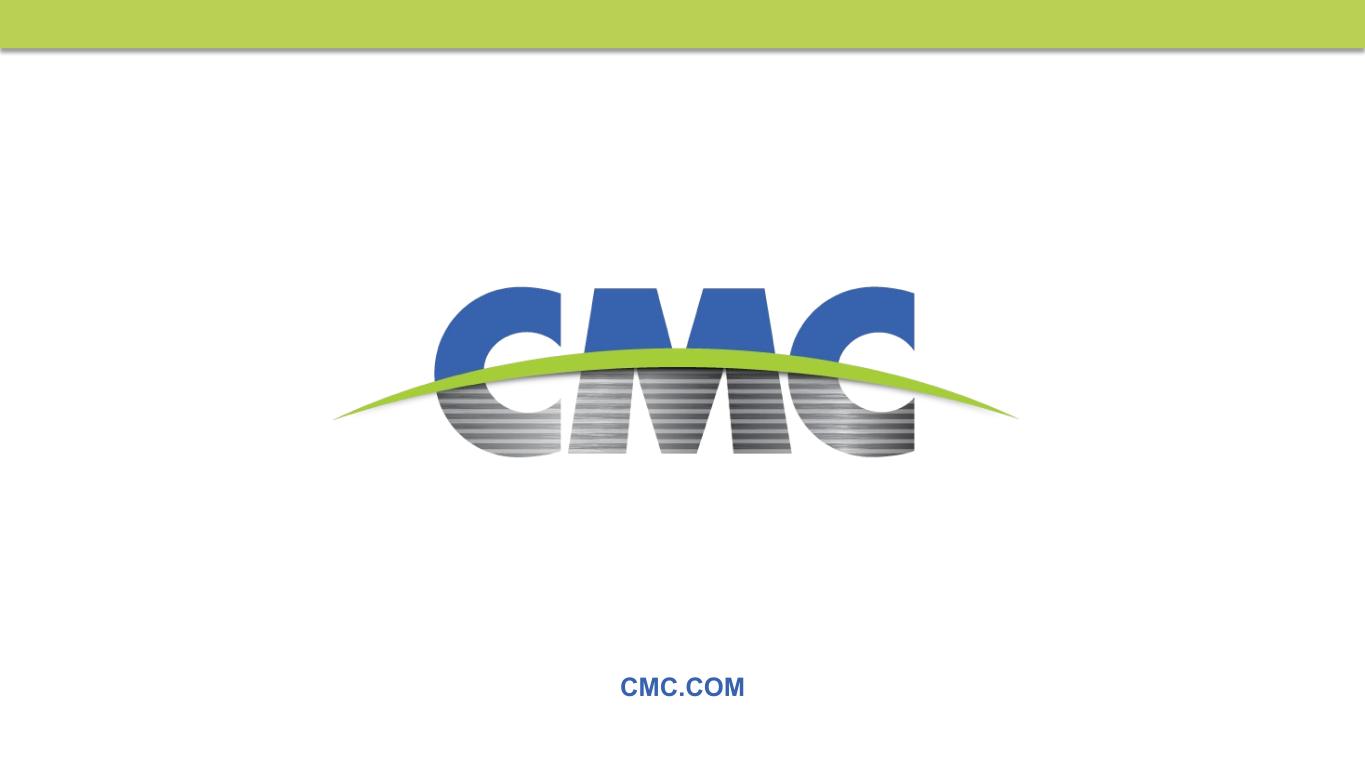
CMC.COM
Document 991
EXHIBIT 99.1
News Release

CMC ANNOUNCES QUARTERLY DIVIDEND OF $0.18 PER SHARE
Irving, Texas - March 19, 2025 - Today, March 19, 2025, the board of directors of Commercial Metals Company ("CMC" or the "Company") (NYSE: CMC) declared a regular quarterly cash dividend of $0.18 per share of CMC common stock. CMC’s 242nd consecutive quarterly dividend will be paid on April 9, 2025, to stockholders of record as of the close of business on March 31, 2025.
About CMC
CMC is an innovative solutions provider helping build a stronger, safer and more sustainable world. Through an extensive manufacturing network principally located in the United States and Central Europe, CMC offers products and technologies to meet the critical reinforcement needs of the global construction sector. CMC’s solutions support early-stage construction across a wide variety of applications, including infrastructure, non-residential, residential, industrial and energy generation and transmission.
Media Contact:
Susan Gerber
214.689.4300
